KAEGI VS. DOWNTOWN LANDLORDS: ROUND 2
BY ALBY GALLUN
Fritz Kaegi, tormentor of downtown landlords, is back at it. After trying unsuccessfully to push through big commercial assessment hikes in Chicago last year, the Cook County assessor is trying again with more than 200 major downtown buildings, including the Aon Center, Prudential Plaza and the Old Post O ce. If Kaegi succeeds, many downtown o ce landlords could face steep property tax hikes at an especially bad time, as they grapple with the worst o ce market in decades.
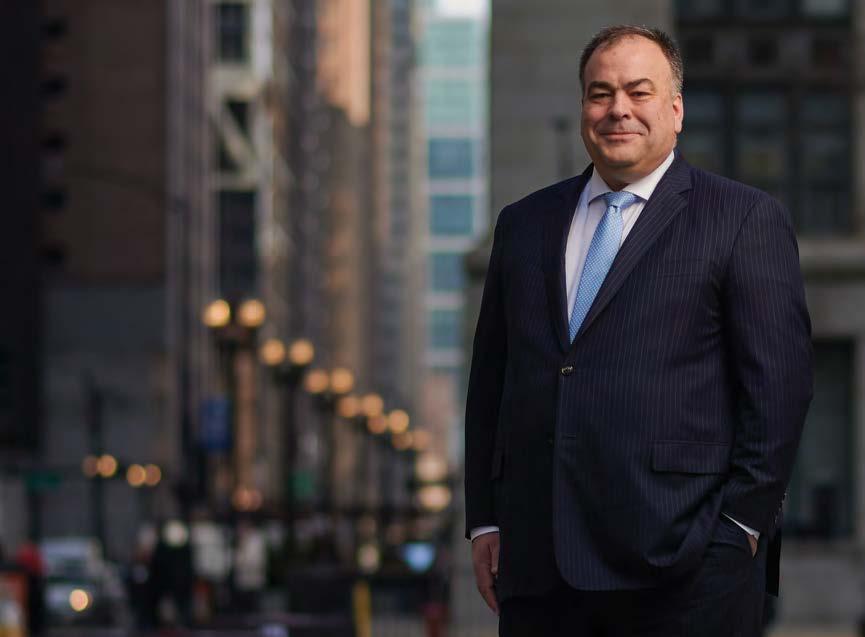
It’s the next round in a ght Kaegi and commercial property owners have been waging since the former investment manager

See KAEGI on Page 18

THE ASSESSOR’S OFFICE MAY SEEM LIKE AN ARCANE BACKWATER OF COUNTY GOVERNMENT, BUT ITS DECISIONS HAVE MAJOR IMPLICATIONS FOR MILLIONS.
City Council is boxed out of budget making
Rushed votes, lack of independent analysis shield mayoral spending plans from aldermanic scrutiny
BY STEVE HENDERSHOT
As Chicago’s second Daley dynasty ended in May 2011, the departing regime left a gift for the new one: a pension-debt problem that had been quietly snowballing for a decade before exploding into view in the runup to the election.
With nearly a third of the City Council following departing Mayor Richard M. Daley out the door, a bewildered cohort of freshmen council members scrambled to understand the mess they had inherited.
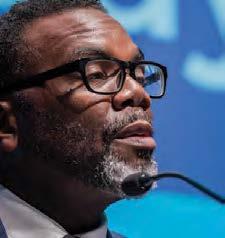
At the turn of the 21st century, the city’s four pension funds all were stable and funded at or near the levels of peer cities. Chicago wasn’t ush, but it was solvent. But in the late 1990s, the state of Illinois sweetened the pension packages and the city didn’t raise its contribution levels. Chicago began falling behind — slowly at rst, during the market boom of the 2000s, and then sharply in
An ongoing collaboration between Crain’s Chicago Business and the University of Chicago’s Center for E ective Government. ChicagoBusiness.com/OneCity50Wards

INSIDE
Want better government? Strengthen the City Council. PAGE 12 Reform of Chicago’s City Council should come from within. PAGE 12
the wake of the nancial crisis of 2008. By the time Daley left ofce, the four pension funds were funded at only about half their levels in 2000.
One of the new council members, 43rd Ward Ald. Michele Smith, dug into the city’s budget to better understand the issues. She felt up to the task, armed with 15 years of experience as
Red ink threatens Allstate’s stock-buyback machine
Hyperaggressive repurchases have shored up the giant insurer’s stock as losses rock its auto insurance business
BY STEVE DANIELS
A terrible 2022 knocked Allstate’s capital to historic lows that endanger the insurer’s aggressive stock buybacks.
Northbrook-based Allstate spent $2.5 billion on share repurchases last year despite posting a


$1.4 billion net loss. In response, Allstate has slowed buybacks slightly. A $5 billion repurchase program that was supposed to be completed by the end of March has been extended through September. ere was $802 million left on that authorization at yearend, and CEO Tom Wilson has

said that will be completed. What happens next? e answer matters because stock buybacks are a major source of Allstate’s investor appeal. e company doesn’t grow much, but its consistent practice of buying back much more stock than it issues each year boosts earnings
Rivian

per share, supporting Allstate’s share price even as its core auto insurance business spews red ink. Allstate’s auto insurance profit margins led the industry until about 18 months ago. Now it’s well into the red, which the

See ALLSTATE on Page 17
customers. PAGE 4
JOHN R. BOEHM CHICAGOBUSINESS.COM | MARCH 6, 2023 | $3.50 PERFORMING ARTS: Chicago’s cultural comeback is falling short. PAGE3 GREG HINZ: What our city needs from Vallas and Johnson . PAGE 2
rate shock coming this month for ComEd
UTILITIES Electricity
JOE CAHILL
may have to consider whether
makes sense to
NEWSPAPER l VOL. 46, NO. 10 l COPYRIGHT 2023 CRAIN COMMUNICATIONS INC. ALL RIGHTS RESERVED
it
go it alone. PAGE 3
This time, the assessor may have an edge in his campaign to boost property tax assessments on trophy towers like the Aon Center and Prudential Plaza I
Tom Wilson
BLOOMBERG See BUDGET on Page 20
What we need now from Johnson and Vallas

For those who like their elections to amount to good versus evil, who consider politics a blood sport entertainment cum cage match, Chicago’s upcoming mayoral runo election should be a thing of joy. By all indications, it’s going to be nasty on steroids, a stark clash of candidates who are as politically and ideologically opposed to one another as any mayoral nalists since World War II.
However, those of us who actually live and work here are hoping for something better. A city at an inflection point needs an honest debate on opposing visions, with a focus not on personalities but the issues at hand, yielding a synthesis of solutions that will engender widespread buy-in. It doesn’t need a racially tinged us-versus-them conflict in which the winner takes all.
How do we avoid the carnage?

Let’s start with the obvious.
The editorial cartoonists are making it out to be Paul Vallas,
champion of the Fraternal Order of Police versus Brandon Johnson, a loyalist to and employee of the Chicago Teachers Union. The resulting polarization writes itself. The reality is more complicated than that, I think — I hope. But it’s now up to each contender in the next six weeks to prove it.



For Vallas, the challenge is to lay out his vision for truly community-based policing and public schools that work for everyone without serving as the tool of either the FOP or big-buck charter school interests. That means detailing how he will fulfill terms of the federal consent decree, fund both a full roster of police and the anti-violence support programs that limit the need for police, and convince cops that respect is a two-way transaction. Core Chicago Police Department culture has to change. It also means selling Chicagoans on the need for things such as competition in the school system and the
closure of schools that are all but empty — selling Chicagoans, not telling them.
For Johnson, the challenge is to spell out how he will fund the programs everyone would like to see, from violence prevention to creating more a ordable housing, without stampeding business and its middle-class workers out of town. Does he still back “defunding” police, however he wants to call it? Does he really think imposing a head tax on any company that wants to create a job is good idea, or raising what already is the country’s highest hotel tax, or irting with a city income tax? All of those are right out of CTU’s playbook. Is Johnson willing to walk away from that playbook and be more than the darling of Milwaukee Avenue hipsters?
Those are sort of threshold tests, as far as I’m concerned. If the contenders pass them, then we can move on to other issues. There are lots of them.
GREG HINZ
ON POLITICS
Like who will fill the key jobs in their administration and kitchen cabinet — who they will listen to. The lack of a deep bench was a recurring problem in the Lori Lightfoot years. Another question: Will they be able to strike the right balance with their legislative branch, neither constantly feuding with aldermen as Lightfoot did nor rolling over them as Richard M. Daley did, but actually collaborate with them, something that Rahm Emanuel did better than any of Chicago’s recent chief executives. And, if they can handle the public safety situation, what is their solution to what is fast emerging as one of this city’s top woes: an unreliable
and uncomfortable public transit system.
It will help that both of the candidates seem focused on this, and only this, job. Though Lightfoot was dealt a bad hand and at times treated unfairly, I found it telling that, a few days ago, while fighting for her political life, she carved out an hour to talk to a New York Times columnist. Some priorities.
For what it’s worth, Chicago, we’re not in this alone. New York and Los Angeles both in the past year and a half or so have had similar left-versus-right elections. Those cities currently have problems at least as bad as ours. Hopefully, we’ll do better.
Final horn sounding on a treasured Hawks era
The Sacramento Kings were the fourth of Dick Motta’s six NBA coaching stops, and when he arrived, he immediately traded Danny Ainge, the team’s best player.
Fan reaction was predictable. “You’ve traded our best player!” they yelped.
Motta was unfazed. “Danny Ainge,” he countered, “is championship caliber. He doesn’t belong in a setting like this.”
at would be buried under a mountain of losses, miles removed from title contention.
e Ainge-Motta scenario comes to mind in response to Chicago Blackhawk franchise great Patrick Kane getting traded to the New York Rangers. Moreso than Ainge, Kane has easily been his team’s best player, but his artistry has often been lost on the pond-hockey kids and beer-leaguers with whom he has been skating, particularly since fellow stalwart Jonathan Toews acknowledged the debilitating e ects of long-haul COVID and stepped aside.
Icon status notwithstanding, Kane and Toews belong on a team with Stanley Cup aspirations . . . if Toews is ever t enough to play again.
Ainge was having a grand old time in Sacramento, given a reat-will green light after being the fth or sixth option on the championship Celtics teams of Larry Bird, Robert Parish and Kevin McHale.
“Even bad teams have a leading scorer,” longtime Kings xture Jerry Reynolds once said in dubious reference to Ainge’s shot selection.
Bad hockey teams have a leading scorer, too, but it’s more di cult — it’s not like one player can dominate the puck and take all the shots.
Kane has always excelled at setting up teammates, so given what he’s playing with, he had done well to collect 42 points (14 goals, 28 assists) in 53 games as of Feb. 22.
He was also on the minus side of the plus-minus stat for the third straight season, with a career-worst minus-25 gure that is jarring.
And he’d want to stay here why?
It’s painful and sad to say this, but watching Toews this season has been like watching Captain Serious at age 78. He nally came clean about long-haul COVID being the culprit that stole his energy; anybody familiar with the condition is astonished that Toews could push himself through 46 NHL games.
So what’s next for the Blackhawks? A dry spell of indeterminate duration.
e fallout from their abysmal handling of the Kyle Beach victimization cost them some of the goodwill Chairman Rocky Wirtz engendered by not being his tight- sted father, but a return to the bad old days of a half-full building, no home TV, and open contempt for a poor product and the aimless succession of people responsible for it seems unlikely. What’s currently happening on the ice isn’t much, but the accompanying show is pretty catchy.
Rocky Wirtz inheriting the team from his late father and hiring marketing magician John McDonough to run it is viewed as the catalyst for the franchise renaissance, but Dale Tallon’s work in the front o ce is really what started it; Kane, Toews, Duncan Keith, Brent Seabrook, Patrick Sharp and Corey Crawford arrived on his watch.
Alas, the NHL salary cap is a cruel and unyielding beast, one
Tallon never could tame. When the center of the 2009 squad that almost made it to the Stanley Cup Final couldn’t hold, it cost Tallon his job, mere weeks after coveted free agent Marian Hossa signed with the Hawks.
“Dale is a good general manager,” Rocky Wirtz told me once. “He just couldn’t count.”
Successor Stan Bowman did a nice job mixing and matching complementary parts to produce three Cups, but no dynasty can withstand age, injuries and that infernal cap.
And the abysmal handling of Kyle Beach.
Rocky Wirtz cleaned house in its
aftermath. His son Danny is the new McDonough, charged with keeping the building lled, which will be a lot easier if GM Kyle Davidson and Coach Luke Richardson can replicate the Tallon-Bowman-Joel Quenneville success formula.
But if there’s a Kane or a Toews or a Duncan Keith out there, he is yet to show himself.
It has been 17 years since Keith
arrived and began delighting United Center crowds with his talent and gumption; 16 years for Kane and Toews. From fresh-faced kids to grizzled vets. e good old days sure ew by quickly.
Crain’s contributor Dan McGrath is president of Leo High School in Chicago and a former Chicago Tribune sports editor.

2 MARCH 6, 2023 • CRAIN’S CHICAGO BUSINESS CORRECTION An article in the Feb. 27 Crain’s Forum, “Find the true value by identifying areas that matter the most,” misstated the year of a Boston Consulting Group study about the e ects of diversity on nancial performance. The study came out in 2018. Banking products pro vided by Wintrust Financial Corp. banks. GET ASSURANCE . LET US GET TO KNO W Y OUR BUSINESS . GET CO MMITMENT . GET AT TENTION. Be your banker’s top priority. WINTRUS T. CO M/PRIORITY DAN McGRATH ON THE BUSINESS OF SPORTS
JOE CAHILL ON BUSINESS
Rivian’s next di cult decision
It’s a time of hard choices for electric vehicle maker Rivian, and the hardest choice may be yet to come.
I think Rivian will have to consider whether it makes sense to go it alone in a fast-growing but increasingly competitive EV market. Here’s why:
Chicago’s cultural venues struggle to fill the seats
The Chicago Symphony Orchestra, Goodman Theatre and other performing arts citadels are facing a scal reckoning as COVID relief funds dry up and attendance lags pre-pandemic levels
I
BY BRANDON DUPRÉ
Chicago’s leading performing arts venues are back, but the crowds aren’t.

e Chicago Symphony Orchestra, Goodman eatre and Steppenwolf eatre say ticket sales rebounded last year from 2021, but not enough to restore their nancial health, as federal dollars that got them through the worst of the COVID-19 pandemic are drying up.
If attendance continues to lag pre-COVID levels, these and other local arts institutions face the possibility of persistent operating losses that could eventually erode their ability to deliver the world-class experiences audiences expect. Industry observers say the situation reveals the obsolescence of a longstanding nancial
See CULTURE on Page 22
“PEOPLE NEED TO BREAK UP WITH THEIR NETFLIX AND STREAMING DEVICES AND GET BACK OUT TO EXPERIENCE THE CITY’S CULTURE AGAIN.”
Erin Harkey, Chicago Department of Cultural A airs & Special Events commissioner
What will happen to Lightfoot’s economic development projects?

The fates of programs she has championed — such as Invest South/West and a LaSalle Street transformation — hang in the balance as she heads for the exit
BY DANNY ECKER
Mayor Lori Lightfoot’s impending exit from City Hall raises big questions about the future of economic development and real estate-focused initiatives she championed over the past four years.
Lightfoot’s wide-ranging Invest South/West program, her recent push to incentivize a LaSalle Street revival with a ordable housing, the planned Bally’s riverfront casino she has pushed forward and even future city sup-
port for an annual NASCAR race around Grant Park that Lightfoot has touted are among the high-pro le e orts that hang in the balance for the next mayor, with little clarity about what will continue, what won’t and who will be making those decisions.
Chicago mayors have historically wielded outsize in uence over economic development priorities for the city, and every mayor has had his or her pet projects. Mayors also play an essential role in marshaling the necessary political and private-sector
support for such initiatives.
Last week’s election results are eliciting a mix of enthusiasm and caution from real estate developers, depending on the types of projects they pursue. eir prospects will also be hard to determine until they know whether Paul Vallas or Brandon Johnson will be the next mayor.
For community developers that target the disinvested neighborhoods Lightfoot has prioritized, the unknown is cause
Illinois’ only current contender in EVs has lost any meaningful rst-mover advantage in electric pickup trucks, despite getting its trucks to market before others. Unlike electric car maker Tesla, Rivian didn’t have the market to itself long enough to establish dominance. It’s already up against deeper-pocketed rivals with stronger brand names and more manufacturing experience. Models from Ford and GMC have hit the market, and others are coming soon.
Rivian’s lost opportunity stems from an array of woes the company continues to battle. Production snafus and supply chain bottlenecks have throttled output at its sole plant in downstate Normal. Rivian failed to meet a sharply reduced production target of 25,000 vehicles last year. Late last month, executives announced a goal of 50,000 for 2023, less than Wall Street expected.
Rising costs for parts and materials plunged Rivian deeper into the red, with operating losses rising 62% to $6.9 billion last year. Cash reserves are shrinking fast as Rivian struggles to learn the complicated, capital-intensive business of auto manufacturing. e company had $12.1 billion in cash at the end of 2022, down 34% from $18.4 billion a year earlier.
In response, Rivian executives are cutting jobs and curtailing growth initiatives. Rivian cut its workforce by 6% twice since last summer, with the latest round announced in early February. It also dropped plans to make electric vans in Europe with Mercedes-Benz and delayed a production platform for lowerpriced vehicles. Management ratcheted back capital spending, which came in at $1.4 billion last year, well below the originally budgeted $2.6 billion.
PAINFUL MOVES
Painful but necessary, these moves are by no means sure to solve Rivian’s most pressing problems. Supply chain constraints persist, and Rivian will need to rev up capital spending again to reach production goals.
Cash consumption will continue for as long as it takes Rivian to master the essential skills of developing, marketing, producing and distributing cars for less money than they sell for.
at means Rivian may soon
face its most painful choice yet: whether it can survive over the long term as an independent company. Unless performance improves markedly, and soon, I think the company’s continuing need for capital, automotive expertise and other capabilities could force executives to seek a buyer.
Raising capital on its own will likely be a lot harder for Rivian now than it was in 2021, when investors poured $13.5 billion into the EV maker’s initial public o ering. Battered by Rivian’s serial setbacks, the stock has plunged nearly 90% from a post-IPO high of $146.07 per share. Another equity o ering would be a tough sell, and likely send the stock even lower.
at leaves debt nancing, an increasingly expensive and chancy option as interest rates rise and lenders grow more cautious.
BUYOUT OPTION
Against that backdrop, a buyout starts looking more attractive. Selling to an established automaker could help Rivian in several ways. Financially, Rivian would gain access to deeper pockets and greater capacity to absorb short-term losses until EV volumes pass breakeven. On the production side, an acquirer could provide a huge pool of auto manufacturing talent. Joining a bigger automaker also could provide leverage over suppliers, bringing down costs and easing supply chain constraints.
Of course, a buyout requires a buyer. And despite its challenges, Rivian does have something to o er an acquirer looking to break into EVs. Rivian could enable an automaker with no EV capabilities to quickly ramp up in the accelerating market.
No, Rivian doesn’t need a savior tomorrow. It has enough cash for the time being, especially if it focuses spending on core production activities. But the time to nd a buyer is before you need one so desperately that you’ve lost all bargaining power.
I also realize that selling Rivian at anything close to its current stock market value would mean a signi cant haircut for investors who bought shares during the heady days following the IPO. Rivian isn’t likely to fetch anything close to those prices in a sale anytime soon.
But Rivian is running out of time to turn itself into a manufacturer capable of competing on an equal basis with the best automakers in the world. At some point, a buyout may be the best investors can hope for, and Rivian’s best shot at long-term viability.
CRAIN’S CHICAGO BUSINESS • M ARCH 6, 2023 3
COURTESY OF GOODMAN THEATRE
Goodman Theatre’s production of “Ohio State Murders.”
See INITIATIVES on Page 7
Downtown condos are selling for long-ago prices
The market’s familiar pattern of poor performance as an investment persists, Crain’s research shows
BY DENNIS RODKIN
Many condominiums in downtown Chicago neighborhoods have performed poorly as investments, selling recently at prices well below what their sellers paid for them years ago.
A few among them are:
A condo on Monroe Street whose $1.51 million sale was 91% of what it sold for exactly a decade earlier.
A condo at Trump International Hotel & Tower whose Jan. 31 sale price of $1.325 million was 31% o of what it went for in 2009.
And one condo on Huron that went for $535,000 this year, down from $617,500 in 2012 and $720,000 in 2008, losing 27% of its value since December 2008.
“In all honesty, you have to give the same speech you’d give if you were a stockbroker,” Rick Druker, managing broker of Baird & Warner’s Gold Coast o ce said. “ ‘ is was not a great investment. It didn’t work out,’ and hope they have other investments that did better.”
e factors are familiar, as they’ve been hurting the downtown market for a few years: crime and the even worse perception of crime, the slower-than-expected recovery of urban downtown areas after COVID shutdowns, and high property taxes that sometimes ward o empty-nesters who would move in from lowertaxed Lake and DuPage county suburbs.
Also contributing is the boom in rental o erings, which allows people to make a less-invested commitment to living downtown.
A study the Chicago Loop Alliance
released last month showed that 78% of people who moved to the Loop in the past year were renters.
In the past two months, Crain’s has counted 21 condos that sold at a loss, most going for less than a decade ago. at’s out of 46 condos sold in that period in a roughly semi-circular area that starts at Division Street and the lakefront, bulges west to include River North and the Loop, and comes back to the lakefront at about Roosevelt Road.
at is, about 46% of the condos sold in that chunk of the city in the past two months went at a loss. But the gure might be higher. For 15 of the properties, Crain’s couldn’t nd a clear past sale price in Cook County property records.
at means of the 29 condos for which a comparison is possible, 21 sold at a loss. Eight sold for higher than their sellers paid for them.
Two more were new construction, with no past price for a comparison.
e missing 15 would help rene these gures a lot. But even if all of them sold for more than their past prices, the total would be 23, only slightly more than are conrmed to have sold at a loss.
“It’s always a disappointment to lose money,” said Keith Estrada, a Jameson Sotheby’s International Realty agent. On Feb. 22, his client sold a condo on Chicago Avenue for $825,000, which was not only less than what the sellers paid for it in 2014 ($1.05 million), but was also less than what the sellers before that paid in 2001 ($1.04 million).
When sellers look at the comparables and understand they’re likely to sell at a loss, Estrada said,
“It’s sometimes hard to swallow, but if they’ve been living here, they probably already knew.”
Cara Bu a, a Berkshire Hathaway HomeServices Chicago agent, agrees that the long-term pattern of losses in the condo market is known to most sellers. “People are pretty well informed by the time they get to me,” she said. “As brokers, we have no control over what the market is doing.”
Bu a represented clients who in mid-February sold a condo on Delaware Place for $1.4 million.
at was down about 8.5% from the $1.53 million the sellers paid in 2019, and down about 9.4% from the $1.55 million sale in 2010.
In the same period that condo dropped in value by 9.4%, the value of a dollar went up 37%.
Not all condo owners see their investments go sour.
A condo on McClurg Court in
Streeterville sold in early February for $552,500, reaping an increase of about 34% for the seller, who paid $413,000 for the two-bedroom unit in 2002. is calculation assumes the seller invested nothing in upgrades over the years. On Wells Street in Printers Row, a threebedroom condo went for $560,000 in late January. at’s about 25% more than the $447,500 the seller paid for it in 2016, and 58% more than the $355,000 the condo sold for in 2011.

Nevertheless, the money-losers are too numerous to ignore. Of the 21 condos Crain’s spotted selling at a loss, 16 sold for less than a price from a decade ago or longer.
e droop is largely con ned to the neighborhoods nearest downtown, except for the West Loop.
e median price of condos sold in the West Loop in January was up more than 28% from a year
ago, according to online real estate marketplace Red n. e Chicago-area condo market overall, while not soaring, has been outperforming the comparables in some other cities. According to data from Red n on six U.S. cities with large numbers of condos, Chicago’s price growth has been comparatively good.
Metrowide, Chicago condo prices rose by 130% between February 2013 and January 2023, according to Red n. e two other markets performing better during that time were Seattle, where prices grew by 185%, and Los Angeles (154%). Lagging Chicago were Boston (119%), Washington (40%) and Philadelphia (43%).
It’s primarily the Loop and its surroundings, long the hub of Chicago jobs and cultural o erings, where the losses are most persistent.
How Chicago won the new Chan Zuckerberg biotech lab
It only took $250 million to get the University of Chicago, Northwestern University and the University of Illinois Urbana-Champaign to learn the value of cooperation
BY JOHN PLETZ
Leave it to Mark Zuckerberg, who made a fortune by bringing 2 billion people together online, to bring together three Illinois universities that have more often competed than collaborated.
The Facebook founder and his wife, Dr. Priscilla Chan, did it by dangling a quarter-billion dollars for a biotech-research center with few strings attached — except that at least three universities participate in each bid.
Mayors and governors — and plenty of outsiders — have long wondered about the possibilities of harnessing three top-tier universities and the talent and capital available in the nation’s third-largest metro area. ey couldn’t help but notice the same ingredients that the Bay
Area or Boston have ridden to economic success.
“You just couldn’t bring them together,” says Paul O’Connor, former head of World Business Chicago under Mayor Richard M. Daley.
Thanks to a combination of pluck, luck and mutual self- int erest, it finally happened. The University of Chicago, Northwestern University and the University of Illinois Urbana- C hampaign partnered in a way they never have before to land the $250 million Chan Zuckerberg Biohub, which was announced March 2.
“ is is the Holy Grail,” O’Connor says. “It changes everything.”
For more than a year, two dozen scientists and the heads of research from the U of C,
U of I and Northwestern spent their Saturday mornings on Zoom working on the pitch to land the project.
e three universities already had a lot working in their favor. In many ways, the Chan Zuckerberg Initiative’s criteria for a follow-up to its successful San Francisco biohub seemed tailor-made for the Illinois schools.
TALENT
As part of its goal to “understand how cells and tissues function and increase our understanding of human health and disease,” CZI wanted the new research center to use embedded sensors and probes to collect biological signals from human tissues. It placed an emphasis on an interdisciplinary
approach, combining engineering and other sciences, such as biology and chemistry.
e U of C launched a molecular-engineering institute in 2011, attracting researchers such as Je rey Hubbell, who specializes in immunology and in ammation.
Northwestern has been building on its expertise in chemistry, materials science and nanotechnology and hired star researchers, such as John Rogers, an expert in micro uidics and implantable electronics, and Shana Kelley, whose research focused on biological sensing.
e University of Illinois launched the Institute for Genomic Biology in 2006, which includes a tissue-research program. e genomics institute and the engineering school already had partnered e orts to design engineered tissues to study and measure individual cells.
“ e whole idea of in amma-
tion and immunity — bringing in nanotech and sensors — intersects with the expertise of all three institutions,” says Rashid Bashir, a biomedical engineer who is dean of the U of I’s Grainger College of Engineering.
It didn’t hurt that the heads of research at the three schools are experts in elds related to what Chan Zuckerberg wanted to do with its next biohub.
Milan Mrksich, vice president of research at Northwestern, is a professor of biomedical engineering; Susan Martinis at the U of I is a professor of molecular and cellular biology. e U of C’s Juan de Pablo is a molecular engineering professor with research expertise in proteins and their relationship to diseases such as diabetes.
“Everyone knows each other pretty well,” de Pablo said. “Previous partnerships helped
4 MARCH 6, 2023 • CRAIN’S CHICAGO BUSINESS
JOHN R. BOEHM
See CHAN ZUCKERBERG on Page 17
Can a high school shed tears?
WE HAVE LOST A FRIEND who was the main reason we’re still here.
Andy McKenna was more than a well-known, widely admired business figure and civic leader here in Chicago. He was the recipient of the first Leo Lions Legacy Award for lifetime service to others.
His belief in us and our trust and gratitude toward him is why we’re still around for the 97th year of our Mission, a beacon of hope on 79th Street.


Andy inspired others to look at what we do for students who can’t a ord us. Scholarships that he helped finance now o er our young Leo Men opportunities they never dreamed of.
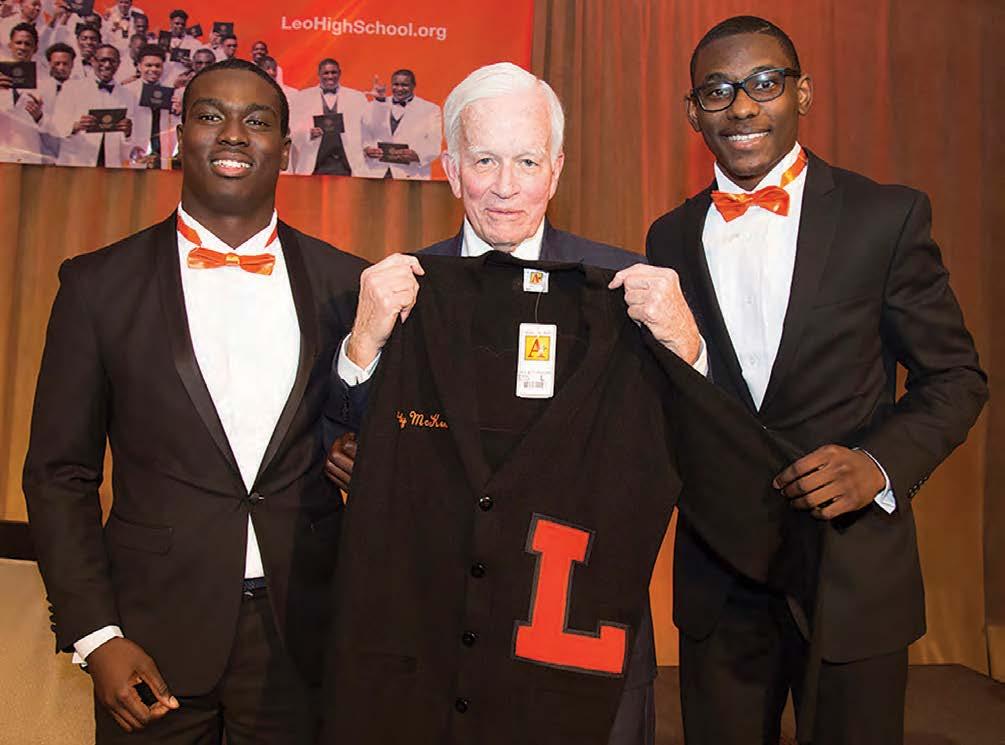
There may never be another Chicagoan as instrumental in lifting the vision of young, needy students toward a better tomorrow. Andy will be missed. But he would have wanted you to meet “our guys” and see the future of Chicago he saw in them, a future that Leo helped Andy see in himself when he was a student here back in the ’40s.
THANK YOU, ANDY. GOD BL ESS.
Dan McGrath ’68, President
Shaka Rawls ’93, Principal
In 2016, Leo held its first Scholarship Benefit. Mr. McKenna accepted the first Leo Lions Legacy Award, and the accompanying Leo school sweater, as recognition for his lifetime of service to others. The young men pictured are Damari Owens ’17 and Aamir Holmes ’17.
7901 S. Sangamon Chicago, Illinois 60620 773-224-9600
Leo Catholic High School Creating possibilities for life
STARTS

Georgian Style Home



Northern
Trust hired workers in ’22 at the fastest clip in a decade
Most of the net new jobs for Chicago’s largest locally headquartered bank were outside the U.S., though
BY STEVE DANIELS
Northern Trust added about 2,500 to the payroll last year, a 12% increase that was the company’s steepest one-year job boost in the past decade.
The global headcount of Chicago’s largest locally headquartered bank totaled 23,600 at the end of the year, according to a Feb. 28 Securities & Exchange Commission filing.

Much of that workforce growth took place outside the U.S. For the first time ever, Northern had the same percentage of employees — 42% — located in the Asia-Pacific region as in the U.S. The remaining 16% worked in Europe and the Middle East.
Over most the past decade, Northern’s annual workforce growth has been around 5%.
In recent years, Northern has hired those additional workers outside its Chicago base. In a strategy to reduce expenses, the company several years ago outlined a vision to bring in new employees in “lower-cost” regions; those didn’t include Chicago.

Northern employs 6,500 in Chicago now, spokesman Doug Holt says. That figure has bounced around over the past few years but is about the same as it was in 2019. Since then, the company has expanded its workforce by 19%, according to SEC filings.
GLOBAL HIRING
Last year marked another large bump in employment abroad for a company whose institutional clients span the globe while growth domestically has been more muted. Still, there clearly was meaningful hiring in the U.S. last year. e U.S. share of 23,600 comes to 9,912. In 2021, the do-
mestic percentage of Northern’s workforce was 43%, but with a smaller base of 21,100 employees, the total was around 9,073.
Northern has a major o ce in Tempe, Ariz., in addition to its headquarters on LaSalle Street and a substantial presence at 333 S. Wabash Ave.
Northern is under re from investors for expense growth last year that well exceeded revenue growth. It responded by saying it would lay o between 300 and 400 early this year.

But even after as many as 400 job cuts, Northern’s headcount is 10% higher than it was at the end of 2021.
RIVALS’ COSTS
By comparison, rival trust banks State Street and Bank of New York Mellon held the line more on costs. State Street’s workforce increased 8% while BNY Mellon’s was up 5% in 2022, according to filings. Northern, State Street and BNY Mellon compete globally in the business of safeguarding and processing transactions involving trillions of dollars for institutional investors, as well as managing money for wealthy families and individuals.
Says Holt in an email, “Northern Trust’s investment globally and in Chicago aligns with our commitment to strengthen our foundation through technology and resiliency, advance our digital modernization efforts and drive growth and client service excellence.”
Northern’s stock is down 6% since reporting disappointing earnings on Jan. 19 and 12.6% over the past year. In the last year, BNY Mellon’s stock has fallen 3.7%, while State Street’s has risen 5.8%.
6 MARCH 6, 2023 • CRAIN’S CHICAGO BUSINESS LUXURY HOME OF THE WEEK Advertising Section IZABELA DIAN OVS KY 847.409.5173 idianovsky@jamesonsir.com Hi
This iconic residence sits on two and a half acres of beautifully landscaped property and has undergone an extensive renovation in the past three years. The exquisite indoor and outdoor features, and unparalleled design, make this property a North Shore oasis! ©2023 Sotheby’s International Realty A liates LLC. All rights reserved. Sotheby’s International Realty® and the Sotheby’s International Realty Logo are service marks licensed to Sotheby’s International Realty A liates LLC and used with permission. Sotheby’s International Realty A liates LLC fully supports the principles of the Fair Housing Act and the Equal Opportunity Act. Each o ce is independently owned and operated PRIVACY
here Chicago Title Land Trust Company will help keep your personal real estate information private. www.ctlandtrust.com 888-878-7856 CONTACT US Chicago Title Land Trust Company
storic
Northern Trust’s global headcount totaled 23,600 at the end of the year.
BLOOMBERG
Lightfoot’s economic development, real estate programs in flux with next mayor
for hand-wringing that some of that momentum will be lost. Yet some also are re-energized by the change, hoping a new administration — perhaps with the highly progressive Johnson at the helm — could be more e ective and e cient in executing economic development projects.
Big developers and commercial property owners downtown, meanwhile, are counting on new leadership to improve public safety measures that might help bring more foot tra c downtown and get institutional investors and lenders to look at Chicago more positively. Vallas’ platform would appear to be more friendly to downtown real estate interests.
“It’s de nitely a point of in ection for the city,” said LG Development Chief Investment O cer Danny Haughney, whose rm is building apartments in the trendy Fulton Market District and also trying to complete a nancing puzzle for a $20 million Invest South/West residential project in Bronzeville. “So much needs to be gured out — there’s a lot for the new mayor to tackle.”
e fate of Invest South/West as a platform to channel more resources into disinvested neighborhoods is one of the biggest questions. Lightfoot billed the program early in her
term as a “Marshall Plan” for 10 investment-starved South and West Side communities, calling for $750 million in public money and resources to be directed into vacancyridden commercial corridors.
Neighborhood developers have widely praised that commitment as a vast improvement from previous administrations and say it is helping to bring new private investors to the table.
Prompted by city-solicited bids that served as the centerpiece of Invest South/West, housing and commercial projects totaling almost $500 million in costs — most of which is slated to come from public funding and incentives — continue to move through various city approvals, some in areas that have gone decades without meaningful investment.
Lightfoot has held a handful of ceremonial groundbreaking events for those Invest South/West projects in recent months, but only one of them — a pair of residential buildings in Auburn Gresham — is actually under construction today. Projects planned in Englewood and Austin have received some permits to begin work, according to the Department of Planning & Development, while others, including LG’s plan, still need approval from the City Council on zoning and public subsidies before they can move forward.
Critics of the Invest South/West program lament the red tape that has slowed those projects, most of which now hinge on the next administration shepherding them forward. But completing them and building on the foundation Lightfoot has laid will be crucial to maintaining the momentum of neighborhood investment, said veteran community developer Leon Walker of DL3 Realty.
“Future administrations will take some lessons learned from the execution (issues), but the underlying policy itself is durable and sorely needed,” said Walker, who recently won a city panel’s approval for more than $10 million in tax-incrementnancing money for an Invest South/ West residential project in South Shore.
HISTORY









Economic development programs and policies have a history of spanning multiple administrations in Chicago. Lightfoot herself leveraged former Mayor Rahm Emanuel’s Neighborhood Opportunity Bonus program — which redirects money from downtown developers into South and West Side neighborhoods — to supplement her Invest South/West strategy. As part of her Chicago Recovery Plan as the COVID-19 pandemic subsides, the city has used Neighborhood Opportunity Bonus and TIF funds to allo-
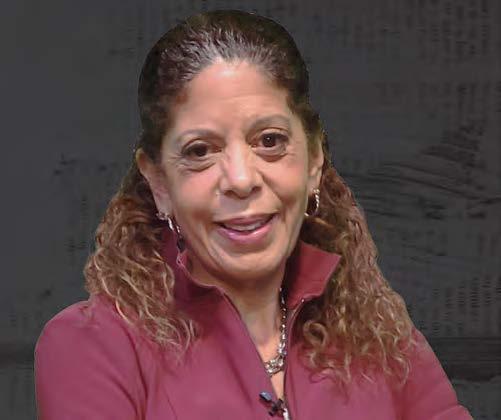
cate 75 grants totaling $55 million for small businesses in Invest South/ West corridors, according to the planning department.


Lightfoot’s nascent initiative for vacancy-plagued LaSalle Street is another key program the next mayor will either choose to adopt, modify or abandon, with the future of Chicago’s urban core at stake. e program dangles subsidies like TIF to developers that will revamp outmoded o ce properties on and near LaSalle with apartments, provided at least 30% of the new units created would be a ordable.
e planning department recently narrowed down a list of proposals for LaSalle Street to six nalists that were presented at a March 2 virtual community meeting. e city aims to announce three projects on which it would be moving ahead by the end of March. at plan envisions development work beginning in 2024.
Chicago developer Mike Reschke, who has proposed two of the six projects and is separately teaming with Google on a plan to redevelop the James R. ompson Center, said he’ll expect to take that LaSalle Street process “week by week” as the city prepares to transition to a new administration. But he’s hoping the change in leadership improves Chicago’s reputation among big nancial partners that may be avoiding the city because
of both real and perceived crime issues.

“I think everybody would have to say Chicago needs change. We’ve been maligned, I think mistakenly, by the national media, and that’s really hurt investor perceptions of Chicago. So change has to be positive,” Reschke said.


Another big unknown for the city’s real estate scene is the future of the planned Bally’s casino in River West, on the current site of the Chicago Tribune’s Freedom Center printing plant. Lightfoot, whose administration last year selected the Bally’s proposal from a handful of bidders, has been counting on the gambling complex to eventually deliver hundreds of millions of dollars in new annual tax revenue to help plug the city’s underfunded pension gap. e mayor’s o ce has been working to push that project forward, but Lightfoot is now due to leave at a tricky moment: Bally’s is still awaiting the Illinois Gaming Board’s signo for its license to run the casino, and another potential roadblock recently emerged as Chicago Tribune parent company Alden Global Capital is said to be driving a hard bargain for Bally’s to buy out its printing plant lease.
As those issues potentially drag on, it’s unclear whether a new administration will be as motivated as Lightfoot has been to help.
CRAIN’S CHICAGO BUSINESS • M ARCH 6, 2023 7 Download the can tv+ app on GET READY CHICAGO!
Zopp CHIC AG O Wednesdays at 7:30pm on CAN TV Watch it on CAN TV 19, streaming live on-demand on cantv.org and on the can tv+ app
with Andrea
INITIATIVES
from Page 3
Brace for electricity rate shock starting this month
 BY STEVE DANIELS
BY STEVE DANIELS
e wholesale cost of energy is at its lowest levels in two years, and Commonwealth Edison customers will be paying the most they ever have for power over the next three months.
Yes, both of those things can be — and are — true.
e average household customer of ComEd will pay about $13 extra per month beginning in March and running through May, thanks to the highest power price ComEd customers will have ever paid and the fact that the cost no longer will be partially o set by payments from the owner of Illinois’ nuclear power plants, ComEd o cials con rm.
e explanation for this strange set of circumstances is a mix of energy politics, subsidies and wildly uctuating energy prices since Russia’s invasion of Ukraine a year ago.
First, the politics and subsidies. Illinois’ Climate & Equitable Jobs Act, or CEJA, enacted in 2021, subsidized three nukes then run by ComEd parent Exelon — now owned by Baltimore-based Constellation Energy Group. The subsidy set a price over five years that ComEd customers would pay for power from those plants.
If actual prices rose above that threshold, Constellation would pay the di erence back to ComEd customers. If they stayed below, customers would pay more to ensure the plants got what the law laid out.
Following the law’s passage, prices spiked and Constellation
was forced to pay beginning last summer. The anticipated credit from the power generator was so substantial that, last summer, it more than offset a remarkable increase in market prices — and kept electric bills manageable in northern Illinois. Gov. J.B. Pritzker and environmentalists who championed CEJA pointed to the result as a triumph for the law, which phases out coal and natural gas as power-production fuels in Illinois until 2045, when they’re banned.
But state regulators, who twice a year run a procurement process that establishes what utility customers pay for energy, opted to lock in for summer 2022, then again for the winter 2022 and spring 2023, at the ultra-high prices prevalent at the time. Since then, those prices have crashed, but customers remain on the hook for the high costs.
at is, until the end of May. At that point, the state will do something it’s never done since the Illinois Power Agency was established more than 15 years ago to run the power-procurement process that previously had been the responsibility of utilities like ComEd — nothing. Or next to nothing, anyway.
MARKET PRICES
Instead of conducting the normal spring procurement that would lock in the cost of most of what’s needed for the summer, the state will allow about half the summer demand to be met by ComEd market purchases on the day before the
power is needed. The Illinois Commerce Commission agreed to this change late last year. Ordinarily, that would leave customers exposed to unexpected price spikes. But Constellation’s subsidy, which CEJA calls a carbon mitigation credit, or CMC, effectively ensures the price can’t be above the threshold in the law, which, for the year beginning June 1, is $32.50 per megawatt-hour.
“To maximize the benefit that the CMC provides as a hedge, we need to be open” to the market rather than locked in, says Scott Vogt, ComEd vice president in charge of power procurement.
The energy cost over the summer — from June through September — is projected to be
about 8 cents per kilowatt-hour. That’s down from the nosebleed price of 9.65 cents for ComEd customers beginning March 1. But it’s nearly 50% above the 5.4 cents that ComEd customers paid last summer after the big Constellation credit was applied to their bills. That translates into about $18 a month more per month for an average household in a normal summer.
CLAWING BACK
Why are costs not coming down more beginning in June? ComEd rebated too much to customers based on what it thought it would get from Constellation per the CEJA credit. ComEd in June will charge close to a penny per kilowatt-hour each month just to begin to claw
back the rebates that turned out too generous.
Even though it’s lower than ComEd’s spring energy charges, that 8-cent charge otherwise is higher than any power price ComEd customers have paid in at least a decade.
CEJA now turns out to make electricity more expensive than it would have been otherwise — at least for the coming summer.
The higher energy costs may well put more pressure on the ICC to rein in ComEd’s proposal for a $1.5 billion delivery rate hike over four years beginning in 2024. Consumers’ electric bills are made up of energy charges, which ComEd passes along at no markup, and delivery charges are the source of ComEd’s profits.
O’Hare gets $50 million from FAA for Terminal 3 upgrades
BY JOHN PLETZ
e FAA is picking up a quarter of the $200 million tab for upgrades set to begin soon at O’Hare International Airport’s Terminal 3.
e $50 million comes from the 2021 infrastructure bill, which included $25 billion for airports. e new money will be used to recon gure the terminal’s security checkpoint, update its baggage handling system, add retail space, widen the corridor between concourses K and L and build restrooms that comply with the Americans With Disabilities Act. e rest of the tab — $150 million — is covered by previously allocated federal funds as well as landing fees and other charges paid by the airlines that serve O’Hare.
Additional Terminal 3 improvements also are planned.
“Americans deserve the best
airports in the world, and with demand for air travel surging back, this funding to improve the passenger experience couldn’t come at a more urgent time,” U.S. Transportation Secretary Pete Buttigieg said in a statement. “These grants will make it faster and easier to check your bags, get through security and find your gate, all while creating jobs and supporting local economies.”
‘ICONIC’
e face-lift is expected to start this summer and be completed in 2025. Terminal 3 is home to American Airlines, the airport’s second-largest carrier, behind United.
“Terminal 3 is an iconic piece of Chicago infrastructure that must remain a key part of the nation’s aviation system for decades to come,” Chicago Aviation Commissioner Jamie Rhee

said in a statement.
O’Hare is in the midst of a major terminal upgrade. Terminal 5, which primarily was used for international ights, has undergone a $1.3 billion expansion over the past four years.
But the big project is the $7.1 billion replacement of Terminal 2, which will create an entry point for inbound international travelers to connect more easily to the domestic terminals serving United, American and their partner airlines.
It also will include new satellite concourses that will boost overall gate space for aircraft by about 25%. Prep work on the new satellite concourses will begin this spring.
e Terminal 2 replacement might also qualify for funding from the infrastructure bill, which provides $1 billion in airport funding annually over ve years.
Rising material, labor and borrowing costs have driven up the price tag since the $8.5 billion program of new terminals and other projects that was announced ve years ago.
Combined with other related capital improvements and maintenance projects, O’Hare is undertaking what’s now projected to be $12.1 billion in assorted construction projects.
8 MARCH 6, 2023 • CRAIN’S CHICAGO BUSINESS
A mix of energy politics, subsidies and uctuating power prices will have ComEd charging far higher prices this spring. Summer doesn’t look great, either.
The average household customer of ComEd will pay about $13 extra per month beginning in March and running through May.
WIKIMEDIA COMMONS
GETTY IMAGES
The face-lift is expected to start this summer and be completed in 2025.
Target, Solo Cup warehouses coming to SW suburbs
Target’s plan to move into a 1.2 million-square-foot building in Joliet is the biggest industrial lease in the Chicago area in more than two years
BY ALBY GALLUN
Two well-known corporate names, Target and Solo Cup, are expanding their industrial footprints in the Chicago area, signing leases for huge warehouses in the southwest suburbs.
In the larger deal, Target conrmed it has leased a 1.2 millionsquare-foot industrial building under construction in the ird Coast Intermodal Hub, an industrial park under construction in Joliet. It’s the biggest industrial lease in the Chicago area in more than two years and part of a multiyear expansion of Target’s local distribution network.

Solo Cup, meanwhile, has leased a 1 million-square-foot warehouse in Country Club Hills built by Chicago developer CRG, according to people familiar with the transaction. e two new distribution centers combined could employ several hundred people, if not more.
e leases highlight the continued strength of the Chicago industrial real estate market, even as higher interest rates and economic uncertainty have caused many businesses to curb expansion plans and cut jobs. e industrial
vacancy rate fell to a record low of 4.5% at the end of 2022 amid a prolonged boom that has brought some glamour to a meat-andpotatoes real estate sector.

e leases also o er an encouraging sign to developers building monster warehouses on speculation, or spec — without signing up tenants before breaking ground.
Developers have been building on spec at a frenzied pace, breaking ground on 88 local spec industrial buildings totaling a record 31.8 million square feet in 2022, according to Colliers.
ough construction has slowed down amid higher interest rates and greater caution among lenders, strong demand for warehouse space will need to continue to soak up all that new supply.
“Both leases demonstrate that industrial demand hasn’t backed o much at all, especially for mega-sized spec warehouse projects,” Craig Hurvitz, vice president of research in Colliers Rosemont o ce, wrote in an email.
e Target spokesman conrmed the Minneapolis-based retailer has leased a 1.2 millionsquare-foot warehouse at 101 Compass Boulevard in Joliet for
a “supply chain facility.” It’s the rst building leased in a 530-acre industrial park approved by the Joliet City Council last May. A representative of the project’s developer, Kansas City, Mo.-based NorthPoint Development, did not respond to a request for comment.
EXPANSION
Target has been expanding its local distribution network in recent years, opening a 1 millionsquare-foot warehouse in Chicago’s Little Village neighborhood in 2021. It followed up last year with leases for two smaller warehouses in Elmhurst and on Chicago’s Southwest Side, near Midway Airport. e chain also operates a 1.4 million-square-foot distribution center in DeKalb and another 1.2 million-square-foot facility in Joliet that opened in 2019, according to real estate data provider CoStar Group.
Target also recently disclosed a $100 million plan to expand its next-day delivery capabilities by opening six new sorting centers around the country.
It’s unclear how many people will work at Target’s new Joliet warehouse. When it opened its Lit-
tle Village distribution center, the company set out to hire 2,000 employees to work there. e Target spokesman declined to elaborate on the retailer’s plans for the Joliet facility, writing that “we’ll have more details to share as we get closer to opening.”
Solo Cup is moving into the Cubes at Country Club Hills, a 1 million-square-foot building CRG developed near the intersection of interstates 57 and 80. Once a private company based in Lake Forest, the maker of the red plastic cups popular with partygoers was acquired in a $1 billion deal in 2012 by Mason, Mich.-based Dart Container.
A Dart spokeswoman declined to comment. CRG announced the lease but declined to name the
tenant, identifying it only as “a national manufacturer.”
e southwest suburbs are a popular spot with many companies seeking distribution space, because they’re close to important crossroads. With warehouses near the intersection of I-80 and I-57 or I-80 and I-55, they can ship goods by truck to a large section of the country in just one day.
“With proximity to a wide swath of the U.S. population, the Midwest ranks as a top industrial market, and modern super-bulk facilities like this one are in short supply,” Je Lanaghan, CRG senior vice president, said in a statement. Brokers at Cushman & Wakeeld represented CRG in the lease, while brokers at Newmark represented Solo Cup.
CRAIN’S CHICAGO BUSINESS • M ARCH 6, 2023 9 On being named President of Management Consulting Learn how Kate and Kaufman Hall’s team support healthcare and higher education clients. Congratulations, Kate Guelich KaufmanHall.com
Solo Cup is moving into this 1 million-square-foot warehouse, the Cubes at Country Club Hills. CRG
is issue must get its due in the mayor’s race
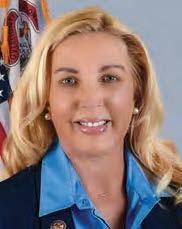
Now that we know who’s in the running to replace Mayor Lori Lightfoot — Brandon Johnson and Paul Vallas — it’s time to get serious about the least talked-about issue on the campaign trail so far: economic development.
ere’s no doubt the dominant themes that shaped the run-up to Election Day — education, housing, transportation and, of course, crime and policing — deserved to be hashed out vigorously as the mayor and her challengers jockeyed for position. All these issues matter deeply to voters, and public safety in particular — or the lack of it — proved to be the deepest thorn in the mayor’s side, the obstacle she could never quite seem to surmount, and the civic a iction that tarnished Chicago’s reputation on the world stage.
at said, Chicagoans can’t hope to solve the problems that ignited such sharp debate in the pre-runo period if the city doesn’t maintain and even shore up its economic base. So it’s been disappointing to see spending priorities and jobs take a back seat — only lightly touched on during debates, if at all — but now there’s an opportunity to put economic policy front and center in the runo .
As Crain’s Danny Ecker reported, Lightfoot’s wide-ranging Invest South/West program, her recent push to incentivize a LaSalle Street revival with a ordable housing, the planned Bally’s riverfront casino she has pushed forward and even future city support for an annual NASCAR race around Grant Park that Lightfoot has touted are just a handful of the high-prole e orts that hang in the balance for the next mayor, with little clarity about what will continue, what won’t and who will be making those decisions.
BOTH OF THE ELECTION DAY SURVIVORS HAVE SKETCHED OUT BROAD ECONOMIC PLANS THAT OFFER CONTRASTING IDEAS ABOUT HOW BEST TO FUND CITY GOVERNMENT, INVEST PUBLIC RESOURCES AND STIMULATE SMALL-BUSINESS GROWTH.
It so happens that both of the Election Day survivors have sketched out broad economic plans that offer contrasting ideas about how best to fund city government, invest public resources and stim -
ulate small-business growth. In a live forum sponsored by Crain’s, Johnson appeared to backpedal away from some of the worst proposals in his blueprint — especially a commuter tax on Metra

riders coming into the city. Vallas, meanwhile, also has laid out some plans — including a pitch to create an independent community development authority that “would operate free from City Hall politics” but be funded by City Hall money, while also envisioning the creation of a municipal bank — ideas that sound a lot like former Mayor Rahm Emanuel’s Infrastructure Trust, which never really produced much in the way of tangible results.
So the candidates have released their economic development manifestos, but each plan contains elements that deserve further scrutiny — certainly more than they have gotten so far. Now Chicagoans can and should start asking Vallas and Johnson to answer some key questions — and then they should focus closely on the answers. For instance:
What is your top spending priority — and how would you pay for it?
What city programs, if any, need to be cut, and by how much?
Is there a clash between creating more jobs downtown and in the neighborhoods? What would be your particular plan for each?
Do you support a city income tax? A head tax on city employers? Annual, in ation-adjusted property tax increases?
What changes, if any, would you make to the city’s tax-increment nancing program?
What further steps are necessary to improve the city’s bond rating?
e positions Vallas and Johnson stake out between now and April 4 will either give employers and investors reason to believe Chicago is open for business — or, on the ip side, further shake con dence in e City at Works.
Lowering energy costs starts with nuclear
As Illinois families and businesses continue to struggle with tightening budgets, lawmakers must prioritize reducing energy costs. There are many factors that play into price increases, including global markets, economic pressures and restrictions of production. However, there is something we can do right now to lower costs — eliminate the state’s arbitrary moratorium that has been restricting the construction of new nuclear power plants for over 35 years.
Illinois is one of just 12 states with such a restriction on the construction of new nuclear power facilities. This restriction has remained in place even though our
state has more nuclear power reactors than any other state, which have efficiently and safely produced carbon-free electricity for Illinois residents for roughly four decades. Additionally, states that have had these moratoriums in place have begun removing them, including West Virginia and Indiana. ese two states have traditionally produced the vast majority of their electricity through coal- red power plants and have recognized the potential nuclear energy can play in a ordably replacing their carbon-producing energy sources.
Thanks to our state’s nuclear energy history, we are poised to take immediate advantage once our own archaic mora -
torium ends. However, if we continue to sit back and allow the moratorium to continue, we risk losing our competitive edge in the nuclear energy industry, especially as newer and safer nuclear energy technology rapidly emerges.
This is why for the past two years I have filed legislation that would delete the language from our books that prohibits construction on any new nuclear power plants, and have advocated that our state take a long and serious look at emerging advanced small modular reactors or so-called “micro nukes.”
“Micro nukes” are small reactors that can be located in small factories, or even inside already existing legacy coal- red

power plants that are scheduled to be decommissioned under Illinois’ Climate & Equitable Jobs Act. An important factor is that these smaller nuclear reactors can be placed in pre-existing coal- red power
plants, which means we wouldn’t have to spend as much time and money building new infrastructure as we currently have to for new renewable projects.
Another added benefit to “micro nukes” is they offer large companies
10 MARCH 6, 2023 • CRAIN’S CHICAGO BUSINESS
EDITORIAL
Sound o : Send a column for the Opinion page to editor@ chicagobusiness.com. Please include a phone number for veri cation purposes, and limit submissions to 425 words or fewer. Write us: Crain’s welcomes responses from readers. Letters should be as brief as possible and may be edited.Send letters to Crain’s Chicago Business, 130 E. Randolph St., Suite 3200, Chicago, IL 60601, or email us at letters@chicagobusiness.com. Please include your full name, the city from which you’re writing and a phone number for fact-checking purposes.
AP IMAGES YOUR VIEW
State Sen. Sue Rezin, R-Morris, represents the 38th District.
“MICRO NUKES” ARE SMALL REACTORS THAT CAN BE LOCATED IN SMALL FACTORIES, OR EVEN INSIDE ALREADY EXISTING LEGACY COAL-FIRED POWER PLANTS.
seeking to reduce their carbon footprint the ability to replace their carbon-producing power plants with carbon-free, reliable and resilient power.
New nuclear power plants, whether they be traditional or “micro nukes,” would also greatly benefit the local economies of traditional coal communities in Illinois that are currently facing the potential loss of hundreds to thousands of permanent jobs once their coal plants’ fires are extinguished. Building 24-hour-producing nuclear power stations in traditional coal territory would infuse millions of dollars by providing good-paying jobs within communities that have become blighted over decades of job loss while dramatically increasing our state’s energy capacity.
As Illinois moves forward with its carbon-free energy goals, it is our duty to, at the very least, give our public utility and energy companies the option to choose whether they want to invest and build the most efficient and reliable means of producing carbon-free energy. It is time for us to end our nuclear energy moratorium by passing Senate Bill 76.
President/CEO KC Crain
Group publisher/executive editor Jim Kirk
Editor Ann Dwyer
Creative director Thomas J. Linden
Director of audience and engagement
Elizabeth Couch
Assistant managing editor/audience
engagement Aly Brumback
Assistant managing editor/columnist Joe Cahill
Assistant managing editor/digital

content creation Marcus Gilmer
Assistant managing editor/digital Ann R. Weiler
Assistant managing editor/news features
Cassandra West
Deputy digital editor Todd J. Behme
Deputy digital editor/audience
and social media Robert Garcia
Digital design editor Jason McGregor
Associate creative director Karen Freese Zane
Art director Joanna Metzger
Digital designer Christine Balch
Copy chief Scott Williams
Copy editor Tanya Meyer
Contributing editor Jan Parr
Political columnist Greg Hinz
Senior reporters
Steve Daniels, Alby Gallun, John Pletz
Reporters
Katherine Davis, Brandon Dupré, Danny Ecker, Jack Grieve, Corli Jay, Justin Laurence,
Ally Marotti, Dennis Rodkin, Steven R. Strahler
Contributing photographer John R. Boehm
Researcher Sophie H. Rodgers
Senior vice president of sales Susan Jacobs
Vice president, product Kevin Skaggs
Sales director Sarah Chow
Events manager/account executive Christine Rozmanich
Production manager David Adair
Events specialist Kaari Kafer
Custom content coordinators
Ashley Maahs, Allison Russotto
Account executives Linda Gamber, Claudia Hippel, Menia Pappas, Bridget Sevcik, Laura Warren
Sales administration manager Brittany Brown
People on the Move manager Debora Stein
Keith E. Crain Chairman
Mary Kay Crain Vice chairman
KC Crain President/CEO
Chris Crain Senior executive vice president
Robert Recchia Chief nancial o cer
Veebha Mehta Chief marketing o cer
G.D. Crain Jr. Founder (1885-1973)
Mrs. G.D. Crain Jr. Chairman (1911-1996)
For subscription information and delivery concerns please email customerservice@ chicagobusiness.com or call 877-812-1590 (in the U.S. and Canada) or 313-446-0450 (all other locations).
A recent Crain’s article (ChicagoBusiness.com/MJmansion) exploring some things Michael Jordan could try to get his Highland Park mansion sold after being on the market for 11 years prompted readers to weigh in on Facebook:
Open it as tourist attraction.
Should Airbnb or hotel.
— Richard Baccay
— Karen Choklad
Michael Jordan Camp for Young athletes . . . Training center plus is a write o . — Markus BlankeCorp
Make it a tourist attraction kinda like Elvis with Graceland. Charge tickets, etc.
— Angelo Gatsios
Level it and turn the entire area into a green space.
— Joseph Michael
But they sell his shoes for $100 million.
— William Creaney

Turn it into a school. It’s big enough. It has a gym, work out, pool.
— Scott Zenger
Bulldoze the freaky structure. Sell the dirt.
— Joseph Fosco
CRAIN’S CHICAGO BUSINESS • M ARCH 6, 2023 11 YOUR VIEW Continued READERS RESPOND
CRAIN’S CHICAGO BUSINESS ChicagoBusiness.com/CareerCente r Connecting Talent with Oppor tunity. Fr om to p ta lent toto p em pl oyer s, Crain’s Career Center is the next step in yo urhiring process or job se arch . G et started to da y
Want better government? Strengthen the City Council.
If there is one o ce I’ve never aspired to, it is that of a Chicago alderperson — not because it is unimportant but because it is. e quality of an alderperson makes not only a di erence, but the di erence, sometimes in the life of the city, certainly in the life of a community and the families and individuals who live there.
It is not the hours or the pay that have kept me from running, but the lack of anonymity. Unlike members of Congress, state legislators, Cook County board commissioners — whose names most people do not know — alderpersons are our neighbors. We see them on the street, at the grocery store or in the park. We can call or stop by their o ces. If we have an urgent issue to discuss, we are likely to be able to reach them on their personal cellphone.
Pundits and journalists point to Los Angeles, New York, Philadelphia, Houston and other cities and ask, Why can’t we be like them? Why can’t we adopt a formal city charter and streamline government, with fewer wards and fewer alderpersons who spend more time on policy and citywide issues?
I lived for 10 years in L.A., and from time to time have lived and worked in New York. I cannot begin to tell you the relief I felt every time I returned home to Chicago (well perhaps not so much in the last four years). Here
the streets are generally clean, building codes are followed, most neighborhoods are intact, and housing prices are relatively a ordable, especially compared to the wholesale destruction of neighborhoods in New York.
Of course, we worry about gentri cation in Chicago. It seems to me however that most longtime residents of underinvested neighborhoods welcome the density and income mix that attracts new stores, new jobs and other amenities. at’s unlike either L.A. or New York, where whole neighborhoods are razed despite the ardent, sometimes massive objections of the residents — if they know about the proposed changes at all.
Doubt me? Talk to the former residents of Fort Green, Dumbo and other historic neighborhoods where now sprawling complexes like Brooklyn Yards have taken the place of organic, human-scale development. Or go to L.A. where, while no one is watching, families are piled into illegally converted garages.
NO ONE TO CALL
In Brooklyn, when my daughter’s landlord took out the back wall of their apartment (while she was attending her fatherin-law’s funeral), there was no one to call; no one to answer the city hall phone; no one to advocate for her.
City Hall in Chicago is hard to reach, too. Try calling the housing, water or building departments, rat control or streets and sanitation. If you get a call back, lucky; if you get a human being, go play the lottery today. And if someone acts on your request, it’s a miracle.
e di erence in the lives of Chicagoans and our neighborhoods are local alderpersons, at least the good ones.
Consider that, when the manager of the Hispanic Housing Development Corp. imperiled senior citizens in their Rogers Park apartment building, it was the alderperson who raised the alarm.
Or take the Hilco issue, in which a botched smokestack demolition caused air-quality issues in Little Village. It was Ald. Mike Rodriguez who acted on behalf of the residents of the ward.
Or in the 10th Ward, it was City Hall that OK’d General Iron’s relocation to the 10th Ward, leaving Ald. Susan Sadlowski Garza to clean up the mess.
It was Ald. Tony Beale in the 9th Ward who, with his local police commander, protected the Walmart on which his constituents depend for food and medicine, when City Hall decided to not send police to the neighborhoods during the civil unrest of 2020. e 9th Ward Walmart was the only one on the South or West Side to avoid looting and vandalism.
Or we can go farther back and look at responsive, active alderpersons like Helen Shiller, Luis Gutierrez and Walter Burnett, who carefully calibrated essential new de-

velopment and investment with protections for residents, assuring that people of more modest means could continue to live in communities as new residents moved in and public and private investment brought jobs, stores and amenities.
Yes, alderpersons could do a better job at legislating, but the answer is not to reduce their numbers but support them with the tools they need to be more e ective in every aspect of their job.
SIMPLE MEASURES
We don’t need a complicated process or even a city charter to get this part right. As early as 2010, City Council members recommended simple strengthening measures including an independent budget analyst and parliamentarian and legal counsel of their own. Former Mayor Rahm Emanuel did not respond. Mayor Lori Lightfoot promised to adopt them but has not acted.
It’s not hard. Give alderpersons what they need to add e ective legislator to their essential role as advocate and agent for the quality of life, voice and well-being of the residents in their wards. Give them adequate sta , an independent budget o ce and access to their own legal expertise. Give them what they need to do every part of their job well, and then we can hold them accountable for a scally sound, compassionate, competitive, amenity- and opportunity-rich city as well as for the local services that contribute to an enviable quality of life for all of us.
Reform of Chicago’s City Council should come from within
The road to hell is paved with good intentions. E orts by reformers to radically ‘improve’ the City Council by cutting the number of aldermen is one such road, writes the former commissioner of Chicago’s Department of Planning & Development.
The road to hell is paved with good intentions. Efforts by reformers to radically “improve” Chicago’s City Council is just such a road.
Marilyn Katz’s recent piece in Crain’s (above) points to this conundrum. Katz is absolutely correct that the real challenge has nothing to do with the size of the council, as the reformers suggest, but rather with it claiming the powers and faculties it already possesses under Chicago’s strong-council/weak-mayor system of government.
Speci cally, Katz suggests that the council should implement several measures it has been considering, including the hiring of an independent budget analyst, as well as parliamentarian and legal counsels. ese are fundamental steps on the road to a more deliberate and e ective council, one that can deal e ectively with whomever the next mayor might be.
Yet there are a few radical reformers who insist that a dramatically smaller council should focus more on citywide public policy and legislative matters and less on what might be considered the mundane worries of neighborhood life, like zoning, land development and parking meters, that professional administrators (under mayoral control) should handle. is is where the road to hell begins.
As Katz points out, under the current system, an alderman’s greatest value is in the accessibility he or she now has with constituents — and with what they perceive (and their constituents believe to be) their duty to protect their constituents’ best interests. So they ght over such matters as construction projects, appropriate uses for vacant property, bar licenses and the like, all those things that dramatically affect a local community’s quality of life.
Now, for the sake of argument, let’s say that the number of wards is reduced from 50, to 10 “superdistricts.” Suddenly the ratio of aldermen to constituents goes from 1-to-55,000 (which already seems high) to 1-to-270,000. ere is simply no way that a superdistrict representative could have the same depth of interest in or knowledge of block-level issues, or the same accessibility that aldermen now have. So in e ect, these issues would indeed be ceded to the executive branch, making the superdistrict representatives even less e ective than today’s aldermen are perceived to be.
POWER BROKERS
On the other hand, legislatively, since there would be only 10 of them, each of the superdistrict representatives could become a formidable power broker in his/her own right (mini-mayors?) and quite possibly roadblocks to the city’s progress.
Another argument for the reduction of the council’s size is that it would save money and make city processes more ef-
ficient. It won’t. With district sizes that would roughly encompass five current wards, each of the districts would have to open fully staffed service offices throughout the district, as well as a central office (probably downtown). And there would likely be calls to create yet another government body, a “District Council,” to advise or even legislate on district concerns.
I worked with city councils and individual aldermen throughout my career, starting in 1979. A few were statesmen, a few were criminals; none were saints. But nearly all were sincerely dedicated to their communities and constituents. As Katz suggests, that radically important element of the close personal touch constitutes one of the most important duties of City Council members today — which would be lost in the midst of many of the pro ered reforms.
Katz is correct: Reform of the City Council should come from within and can be done now with little more than the determination of the council itself. at’s the road to reform that should be taken.
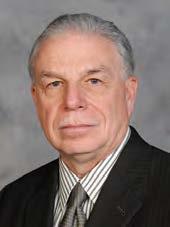
12 MARCH 6, 2023 • CRAIN’S CHICAGO BUSINESS
Yes, alderpersons could do a better job at legislating, but the answer is not to reduce their numbers but support them with the tools they need to be more e ective, writes a longtime media consultant to city government.
Marilyn Katz is president of MK Communications, a public policy strategy and communications rm. She has worked with city governments since 1983.
Andrew J. Mooney is a former executive director of the Chicago Housing Authority and most recently was commissioner of the city of Chicago’s Department of Planning & Development.
BANKING
Customers Bank, Chicago
Customers Bank hired industry veteran Frank Bukowski as Managing Director, Fund Finance to cover Financial Sponsors within its expanding Fund Finance Group. With 3 decades of experience banking alternative asset managers and hedge fund administrators, he will cover Private Equity, Venture Capital, Hedge Fund, and Private Debt Funds in the Midwest. Bukowski’s previous experience includes JPMorgan’s Funds Group where he served as executive director and covered similar clients within the region.

BANKING / FINANCE
Wintrust ESOP Finance, Chicago

Wintrust is proud to announce the promotion of Patrick Stoltz to President of the Wintrust ESOP Finance team. Pat has 31 years of commercial banking experience and a proven track record of developing and building relationships, nancial analysis, and risk management. Throughout his career, Pat has been responsible for leading a team of bankers tasked with generating middle-market opportunities in the Chicagoland area and new and mature ESOP opportunities across the country.
EDUCATION
McNair Scholars Program at DePaul University, Chicago

Alex Jackson, Assistant Director of the McNair Scholars Program at DePaul University, has joined Embarc’s Board of Directors. Alex will support Embarc in transforming Chicago’s education system into the most experiential and equitable in the country. Alex is a current Doctoral (EdD.) student at DePaul University, completing research based on racial inequities for Black Women in Higher Education and breaking down barriers for rst-generation and underrepresented students.
To place your listing, visit www.chicagobusiness.com/peoplemoves or, for more information, contact Debora Stein at 917.226.5470 / dstein@crain.com
HEALTH CARE
SHIFT, Chicago
Brian Hollett, M.D., M.B.A. has been named Chief Medical Of cer of SHIFT, an integrated concierge medical practice comprised of physicians, dietitians, physical therapists, and tness coaches. Previously, he served as a practicing physician at SHIFT, where he constructed a proprietary system for health coaching and spearheaded the company’s preventative health screening approach. Dr. Hollett will lead the design and growth of clinical operations in new SHIFT sites planned for 2023 and beyond.
Nixon Peabody LLP, Chicago
Nixon Peabody LLP is pleased to announce that Christie Kurow of our Complex Disputes practice, and George Dandalides of our Intellectual Property practice, were promoted to counsel.
Chicago Mutual Aid Association, Chicago

CMAA, a leading Asian American social services agency serving immigrants and refugees in metro Chicago, welcomes Dr. Luyan Li and Ajay Shah to its board of directors.
Krieg DeVault LLP, Chicago
CONSTRUCTION
W.E. O’Neil Construction, Chicago
W.E. O’Neil Construction is proud to announce the promotion of Rick Jeschke and Chris Ameika to Senior Preconstruction Managers. Rick has been with W.E. O’Neil for 22 years. With his deeply rooted operations and estimating background, Rick’s new role in preconstruction will enhance W.E. O’Neil’s client experience in early project analysis, planning, budgeting, and startup.
Chris has 24+ years of industry experience working with major owners and developers managing and estimating high-pro le projects locally and abroad. He has helped lead W.E. O’Neil’s Preconstruction and Estimating Department to new levels by delivering on some of their most recent marquee projects including the new ground up RIU hotel tower in downtown Chicago.
EXECUTIVE RECRUITMENT
Comhar Partners, Chicago

Adam Zak has joined Comhar Partners as a Managing Director. He will be leading the rm’s Operations & Operational Excellence practice. Adam’s 30+ years of experience targets senior executives in C-level, Vice President, or Director roles across a broad range of industries including Industrial Goods and Services, Automotive, Supply Chain, and Private Equity. His focus and process, deeply aligned with Comhar Partners, are client-driven and highly collaborative.
FINANCIAL
SERVICES
FORVIS, LLP, Chicago






FORVIS, LLP is pleased to announce the expansion of its Loan Review team in the Chicago market with the addition of Tom Chester. Chester comes to FORVIS from an international professional services rm with extensive experience in commercial and corporate banking credit analysis, portfolio management and credit review, and asset quality portfolio reviews. Chester holds a Bachelor of Science degree in accountancy.
Roger Carlson has joined the law rm of Krieg DeVault as a Partner in the rm’s Business Practice. His practice is concentrated in the areas of commercial real estate, buying and selling businesses, contract negotiations, corporate nance, and general representation of various business entities and their principals. He also has extensive experience in representing lenders on new loans and restructuring distressed and non-performing loans.
Porter Wright Morris & Arthur LLP, Chicago
Michael Kelly and John Shapiro are partners in Porter Wright’s Litigation Department. Michael works with clients on complex litigation cases involving antitrust, contract, insurance, intellectual property and trade secrets, often involving novel issues. He graduated from University of Notre Dame and received his J.D. from DePaul University College of Law.
John works with clients to solve their most complex business disputes, counseling on litigation, employment and business issues, and providing general corporate advice, nonpro t corporation management and guidance on governance. He graduated from Carleton College and received his J.D. from University of Minnesota Law School.

Christie represents clients in state and federal courts and arbitrations nationwide. She focuses on litigation involving trade secret misappropriation, restrictive covenants, breaches of contract and duciary duties, fraud, and corporate raiding claims. George helps clients protect their IP by providing strategic advice, building strong patent portfolios, and drafting patent applications. With a background in physics and computer programming, his practice focuses on preparing and prosecuting both U.S. and foreign patent applications.
Li Shah
Dr. Luyan Li is the COO of St. Augustine College, the rst bilingual higher ed institution in the Midwest. On top of her experience with overseeing nancial matters for Medexus Pharma Inc. and PCMA, she manages multiple departments, operational procedures, policymaking, program evaluation.

Ajay Shah is the CEO of Globetrotters Engineering Corporation, an architectural engineering company that has delivered multi-disciplined design projects throughout the Midwest. He has a strong commitment to public service, having over 20 years of experience in law & community involvement.



NON-PROFIT
IFF, Chicago
Nixon Peabody LLP, Chicago
Nixon Peabody LLP is pleased to announce that Gretchen Sherwood of our Project Finance & Public Finance practice has been promoted to counsel. Gretchen regularly serves as underwriter’s counsel or bank counsel on nancing transactions for health systems, charter schools, colleges and universities, and other nonpro t entities. She also represents borrowers in structuring and negotiating their taxable and tax-exempt nancing transactions, and advises clients on ongoing compliance matters.
IFF has promoted Cynthia Copp to managing director of community data insights, leading a specialized team of geospatial analysts that plays a critical role in the organization’s work to solve community development challenges in the Midwest. Previously the director of spatial analytics, Copp joined IFF in 2018 and brings more than 30 years of experience to the role. She holds a bachelor’s degree in economics and a master’s degree in urban systems and policy planning from Northwestern University.
REAL ESTATE
Transwestern, Chicago
Nixon Peabody LLP, Chicago



FINANCIAL SERVICES
Getzler Henrich & Associates, Chicago

Kevin A. Krakora has been named the Automotive Practice Leader of Getzler Henrich & Associates LLC, one of the nation’s oldest and respected middlemarket corporate restructurings and operations improvement rms. A long-time Managing Director with the rm, this announcement of Mr. Krakora’s leadership of the Automotive Practice is recognition of both his depth of knowledge and longtime automotive industry-centric service, and the signi cance of dedicated industry services groups.







LAW FIRM
Wallace Miller, Chicago
Wallace Miller is thrilled to welcome Molly Condon Wells as the rm’s newest partner. Molly represents plaintiffs in large-scale complex litigation, including class actions and mass torts. “Molly has been with the new rm since day one, and has proven, time and again, her outstanding abilities as an attorney and an unwavering commitment to our clients,” said Wallace Miller partner, Mark Miller. Proudly headquartered in Chicago, Wallace Miller’s practice is nationwide.




Nixon Peabody LLP is pleased to announce that Kelly Glynn has joined the rm as an associate on our Corporate Tax team. Kelly’s experience includes advising U.S. and foreign multinational clients on cross-border tax issues. Prior to joining the rm, Kelly was an international tax senior manager at Ernst & Young LLP. She has several years of law rm experience, including as a tax controversy and general litigation associate. Kelly earned her J.D. from the University of Notre Dame Law School.

Transwestern Real Estate Services welcomes Caitlin Ritter as Research Director for Chicago and Rosemont. Ritter will spearhead research initiatives that cover commercial real estate activity in Chicago and the suburbs. Previously, Ritter worked at Aegon Asset Management and MBRE. While at MBRE, Ritter’s reports and thought leadership pieces were consistently praised across the industry and cited in multiple publications.

WEALTH MANAGEMENT



Mesirow, Chicago
To order frames or plaques of profiles contact Lauren Melesio at lmelesio@crain.com or 212-210-0707
Andrew Mutlu, CFP®, APMA® has joined Mesirow Wealth Management as a Wealth Advisor. Andrew will focus on providing comprehensive wealth planning and constructing investment strategies that are tailored to t the needs of high net worth individuals and families. Andrew earned his Bachelor of Science from Ohio University. He is a CERTIFIED FINANCIAL PLANNER™ professional and an Accredited Portfolio Management Advisor. He holds the Series 7, 6, 63 and 65 FINRA licenses.
PEOPLE ON THE MOVE Advertising Section
LAW FIRM
LAW FIRM
LAW FIRM
Kurow
Dandalides
Jeschke Ameika
LAW FIRM Kelly Shapiro
LAW FIRM
NON-PROFIT
State Farm posts record $6.7B loss as inflation takes a toll

The insurance giant posted a mind-boggling $13.4 billion in underwriting losses in its auto insurance unit. But homeowners insurance swung to a pro t.
BY STEVE DANIELS
State Farm’s 2022 was a record breaker — in all the wrong ways.
e Bloomington-based insurance giant posted a net loss for the year of $6.7 billion, by far its most unpro table year ever. at compared with a $1.3 billion net pro t in 2021.
Driving that loss was a staggering $13.4 billion in underwriting losses at State Farm’s auto insurance business. e company lost money insuring vehicles before it covered even a penny of operating expenses. Claims and loss adjustment expenses totaled $48.4 billion, while the premiums State Farm earned came to $45.7 billion.
U of I is getting into the business of angel investing
A new program, Illini Angels, will allow alumni to back startups coming out of the university and those created by University of Illinois graduates
BY JOHN PLETZ
e University of Illinois at Urbana-Champaign is getting into the angel investing game with the launch of Illini Angels.
The program will allow U of I alumni to invest in startups coming out of the university, as well as companies started by students after they leave. Illini Angels will be overseen by the university’s venture-capital fund, Illinois Ventures.

“Alumni for a long time have wanted to be more involved in what’s coming out of the university and people who wanted to help startups,” said Nancy Sullivan, CEO of Illinois Ventures, which floated the idea to 35 to 40 alums last fall.
Angel investing, or backing from individual investors, is often a crucial component in getting startups off the ground, providing the earliest stage of funding that helps entrepreneurs get far enough along to attract traditional venture-capital firms. Most angel groups are ad hoc collections of individual investors who can pick and choose which deals they want to invest in, unlike the all-or-nothing approach of a traditional fund.
U of I, whose alums founded Netscape, PayPal, YouTube and Affirm, has long been
one the nation’s most reliable sources of startups.
But it’s coming late to the alumni-investing party. Alumni with connections to the University of Chicago, Notre Dame and Harvard Business School all have launched angel investing groups in recent years.
MORE ANGELS
Hyde Park Angels, which started in 2007 by people connected with U of C’s Polsky Center for Entrepreneurship, is the best known. It has 147 investors and 55 active investments, including startups such as ShipBob, Simple Mills and Four Kites. Hyde Park Angels, now known as HPA, groups its investments in three-year cohorts. It has invested $100 million in the past three cohorts.
Irish Angels, a Notre Dame-connected angel group with about 240 members, has invested $60 million in more than 90 companies since it was founded in 2012.
Harvard Business School Alumni Angels of Chicago has invested more than $70 million in more than 300 companies since it launched in 2012.
Most angel groups meet quarterly to hear pitches from startups. Illini Angels will hold its first pitches this month.
To put that in perspective, the underwriting auto loss State Farm su ered came to 45% of the $29.7 billion in total auto premiums earned by fellow Illinois-based giant Allstate in 2022.
Of the big four U.S. auto insurers, all but one — Progressive, based in the Cleveland suburbs — lost money insuring vehicles. State Farm’s auto losses were nearly three times the $4.9 billion in combined auto losses for Allstate and Chevy Chase, Md.-based Geico.
at the loss was record-breaking wasn’t a surprise, given State Farm’s auto and homeowners’ results at the end of the third quarter. But the numbers still are jarring when looking at the enterprise as a whole, which the company discloses just once a year.
State Farm has hiked auto rates across the country in response to the intense in ationary pressures
that have a icted the industry. While the company’s rate hikes haven’t been as dramatic as Allstate and Geico, it’s now signaling that increases will continue and maybe intensify. Indeed, coincidentally, State Farm just led for a 6.5% average auto rate hike in Illinois, taking e ect this month.
‘FINANCIALLY STRONG’
“While 2022 was a year of significant growth at State Farm, our annual operating results were not at the level we expect as we consider each a liate’s nancial strength and long-term performance. At the same time, the organization remains nancially strong,” Chief Financial O cer Jon Farney said in a statement. “We’re pleased we could assist our customers during the pandemic, and we’re there to help them navigate the current period of high in ation. As we take actions to improve our operating
performance, we look forward to helping more people in more ways as we begin our next 100 years.”
Unlike its main rivals, State Farm isn’t publicly traded or part of a publicly owned conglomerate. As a mutual insurer, technically owned by its policyholders, it isn’t subject to shareholder pressure that would mount in reaction to results like these.
It also is extraordinarily well capitalized. Net worth fell by more than $12 billion in 2022, but the company still had capital on the books of $131.2 billion.
One bright spot: Homeowners insurance swung to an underwriting pro t of $849 million from a $1.1 billion loss in 2021. State Farm is the largest insurer of homes, as well as cars, in the country.
Unspeci ed negative returns in State Farm’s investment portfolio, fueled by stock losses, contributed to the red ink as well.
State Farm isn’t done raising auto rates
The latest hike comes on top of a big increase imposed in September
BY STEVE DANIELS
State Farm is raising rates for Illinois drivers it insures by 6.5% on average.
e rate hike, the latest in a series from the state’s largest auto insurer, will add about $58 to the annual premium for the average policyholder, according to a ling with the Illinois Department of Insurance.
Bloomington-based State Farm issues more than 3 million auto policies in the state, insuring about one in every three drivers.
e latest price hike, slated to take e ect this month, comes just six months after an 8.4% average increase. at lifted the average annual premium by about $69.
Most auto insurers have been rapidly hiking rates to catch up to in ationary pressures that have made many of them unpro table on an underwriting basis.
State Farm’s increases are more modest than those by Northbrook-based Allstate, the second-largest Illinois car insurer, and even Chevy Chase, Md.-based Geico, which advertises how cheap it is compared with major rivals.
“As we have previously shared, we are continuously monitoring and adjusting to trends,”
State Farm spokeswoman Gina Morss-Fischer said in an email.
“In ationary pressures and supply chain issues, combined with higher claim costs are driving rate changes. We continue to adjust to these trends to make sure we are matching price to risk.”
State Farm also announced its 2022 nancial results last week, posting a net loss for the year of $6.7 billion, by far its most un-
pro table year ever. e company is a mutual insurer, technically owned by its policyholders, and has an enormous surplus. at enables State Farm to absorb billions in losses without worrying about its nancial condition or about shareholder reaction.
While many other rival insurers, like Allstate and Geico, say they have pulled back on advertising as they adjust pricing, State Farm has continued to blanket the airwaves with ads featuring “surprisingly great rates.”
e number of State Farm’s policies in Illinois has risen over the past year, while Allstate’s and Geico’s have dropped. Nationally, Geico saw its auto policies fall 9% in the year that ended Dec. 31, according to a recent ling by parent Berkshire Hathaway, an unheard-of result from an insurer that has been the fastest growing in the industry over the past two decades.
14 MARCH 6, 2023 • CRAIN’S CHICAGO BUSINESS
The program will allow U of I alumni to invest in startups coming out of the university, as well as companies started by students after they leave.
NEWSCOM
YOUTUBE







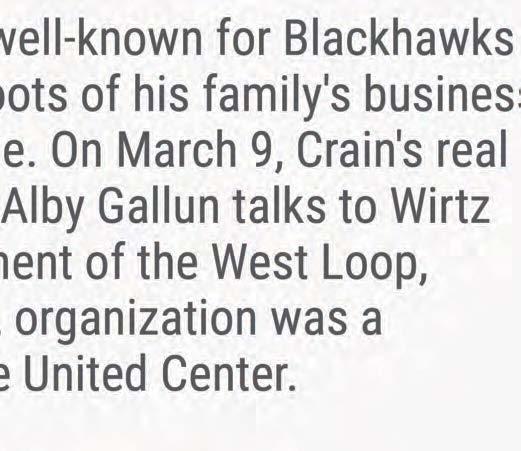






Buddy Cohen, brash mortgage banker, dies at 93
Cohen, who was involved in Lake Point Tower and the East Bank Club, was a key dealmaker in an era when the business depended on cultivating relationships
 BY STEVEN R. STRAHLER
BY STEVEN R. STRAHLER
Benjamin Cohen, a colorful and relentless mortgage banker and real estate investor involved with names like Judd Malkin and memorable projects like Lake Point Tower, died Feb. 25 at his home in Rancho Mirage, Calif. He was 93. His son Bruce said the cause was heart failure.
In an era before Wall Street institutionalized real estate nance and the business depended more on cultivating relationships, Cohen was an exacting dealmaker in Chicago’s rough-and-tumble industry. He arranged nancing for Malkin’s JMB Realty and Jerry Reinsdorf’s Balcor and for the East Bank Club, the Holiday Inn above the Apparel Mart and McClurg Court in Streeterville, whose syndication among 28 lenders was a coup for its day.
Cohen, who went by Buddy, was among a group of investors who seized control of Exchange National Bank in the late 1970s, which led to the hiring of Norman Bobins, paving the way for his remarkable impact on the city’s banking landscape.
“He had a mind for numbers, location and structure like nobody else,” said Bi Ruttenberg, who began his real estate career chau euring Cohen and listen-
ing to him wheel and deal over what was then called a car phone. Despite an us-versus-them mentality, Cohen knew how to charm people, realizing that “until they buy you, they’re not going to buy what you’re selling,” Ruttenberg said.
Cohen grew up in West Rogers Park and went to Latin School. His parents, Jack and Mildred, owned a company that “would essentially gather rags and sell them to the mills,” according to Bruce Cohen. Buddy Cohen lettered in football — playing quarterback and linebacker in the two-way system of the times — at the University of Wisconsin. He worked in the family business, including a posting to Japan, before sitting next to a mortgage banker here at a luncheon and nding his career, starting as an industrial broker.
In 1957, he partnered with Louis Kahnweiler and Milton Podolsky in what became, at six square miles in Elk Grove Village, the largest industrial park in North America. By 1965, he had started his own rm, B.B. Cohen & Co., which was sold seven years later to Walter E. Heller Financial, a commercial nancier interested in Cohen’s lending portfolio. Heller also owned American National Bank, where
Bobins worked. When Cohen, along with Ira Kaufman and Robert Dunn Glick, bid for Exchange National Bank, Bobins arranged a $10 million loan for the transaction; two years later Bobins himself was at Exchange.
“We had been friends, and he felt it was a great opportunity,” Bobins said of Cohen. “He was driven. He was a stubborn guy, but if he was your friend, he was a friend for life.” Bobins rose to the top after Exchange’s merger in 1990 with LaSalle National Bank while fostering the banking careers of many American National alums and other bankers. LaSalle was sold in 2007 to Bank of America.
FINANCING
Meanwhile, Cohen started a second rm, Cohen Financial, in 1978 after a noncompete agreement expired with Heller. A decade later, he was in and out of the news during a takeover of another mortgage banking company started by protégés. His son said he helped nance the CBOE, 150 N. Michigan Ave., 2 N. LaSalle and 10 N. LaSalle buildings, and partnered with Malkin and others on various projects.
Cohen used his relationships with insurance company lenders, moving from arranging nancing
for developers to investing in their deals and growing wealthy.
“He helped me structure a deal for 225 acres of garbage,” a Southeast Side land ll operated by then-little-known Waste Management in the mid-1970s, Ruttenberg recalled, by securing a $3.6 million mortgage from two midsize insurance companies relying on each other for peace of mind. “ at was part of the genius, to get two companies to do it.”
At 75, Cohen returned to his roots in industrial real estate, building a portfolio of several million square feet that was sold in 2019 to Prologis, according to Bruce Cohen, who also pursued a career in real estate nance.
He’s the CEO of Temerity Strategic Partners.
Buddy Cohen’s football days ended with a broken leg. Ron Frain, whose playing career at Wisconsin also was cut short by injury, remembers Cohen telling him, “ ere are other things in life.”
Frain followed Cohen’s advice, co-founding what is now Bridge Industrial in 2000. “He would challenge you a little bit, to make sure you were thinking correctly,” said Frain, now a partner in developer Sterling Bay’s industrial group. “He would ask the tough questions that other people dance around. Some people like that, some don’t.” Services were held.
Vacant suburban office property goes up for auction
The empty former Hewitt Associates building in Lincolnshire stands to add to the list of outmoded suburban o ce properties selling at steep discounts
BY DANNY ECKER
e owner of an empty o ce building in Lincolnshire has put it up for auction, adding to a series of outdated suburban o ce properties in line to be sold o the discount rack as remote work continues to beat down demand for workspace.
e 318,043-square-foot building at 2 Overlook Point in the northern suburb is slated to be sold in an online auction that begins March 20, according to a marketing yer from real estate services rm Jones Lang LaSalle. e ve-story building, which was designed for and occupied by corporate consultant Hewitt Associates when it was completed in 1997, is part of the 330-acre Lincolnshire Corporate Center along the west side of Milwaukee Avenue.
ere is no starting bid price listed for the property, but auctions of other vacant suburban o ce buildings suggest buyers will start low. e empty former CVS Caremark o ce building at 2211 Sanders Road in nearby Northbrook was sold via auction in December for just under $2.3 million, or less than $12 per
square foot, according to Cook County property records.
Auctions are typically a last-resort option for sellers, often indicating the lack of investor interest in a deal that would otherwise be coordinated by a broker.
e decimated property values re ect the long-standing headaches for owners of outmoded o ce buildings in the suburbs, pain that was intensi ed by the COVID-19 pandemic. Companies slashing their o ce footprints have driven up vacancy to an all-time high, forcing building owners to ramp up both amenities and lease perks to lure or retain tenants.
WARINESS
For buildings like 2 Overlook Point that need dramatic investment to even start to compete for new users, investors are wary that pouring money into them may not be worth it, given the weak leasing market. About 70% of all new o ce move-ins in the suburbs last year were in top-tier, or Class A, o ce buildings, often by tenants moving from older or more outdated properties, according to JLL.
at’s the quandary facing
the venture of Stamford, Conn.,based Twenty Lake Holdings, which paid just $4.4 million in 2019 for the vacant 2 Overlook Point building, property records show. Hewitt occupied the building for roughly a decade before subleasing it in 2007 to Walgreens, which later vacated the property. Hewitt was acquired in 2010 by insurance giant Aon, which has an o ce today at nearby 4 Overlook Point.
It’s unclear why Twenty Lake is now looking to unload 2 Overlook Point, and a spokesman for the company did not respond to a request for comment. Twenty Lake is a commercial real estate-focused a liate of controversial New York-based investment rm Alden Global Capital, known locally for the past several years as the parent company of the Chicago Tribune.
JLL is marketing the property as an opportunity for a buyer to add value by renovating it and bringing in one or more new ofce users. But people familiar with the o ering also foresee industrial developers emerging to bid on the property with the intent to demolish it and replace it with a warehouse. Demand for
such space to store and distribute goods bought online has soared since the pandemic began, and the Lincolnshire Corporate Center already includes warehouse space.
ALLSTATE CAMPUS
In the highest-pro le o ce-towarehouse conversion play in the area, a Nevada developer is turning the former Allstate corporate campus in Glenview into a eet of industrial buildings. A Chicago industrial developer is working on a deal to do the same with

the 101-acre Baxter International headquarters in Deer eld. e 2 Overlook Point property is zoned for both o ce and light industrial uses, according to the JLL yer.
O ce vacancy in the suburbs ended the year at 27.9%, according to JLL research, up from 22.1% when the pandemic began. e capital markets team in the JLL Chicago o ce is marketing the building on behalf of Twenty Lake. RealInsight Marketplace is conducting the online auction.
16 MARCH 6, 2023 • CRAIN’S CHICAGO BUSINESS
Lake Point Tower was among Cohen’s memorable projects.
MARCIN WICHARY VIA FLICKR
2 Overlook Point in Lincolnshire
JONES LANG LASALLE
How the Chan Zuckerberg Initiative finally brought together 3 Illinois schools
pave the way.”
e U of I and U of C got business and engineering students to work together on business-plan competitions. Another e ort involved a laboratory in Hyde Park, but the facility didn’t get built as planned. en, ve years ago, the two schools partnered on a quantum-computing initiative that landed $200 million in state funding.
Several of the researchers also had collaborated with or knew Steve Quake, a Stanford professor of bioengineering and applied physics, who leads the Chan Zuckerberg Biohub program.
A LONG SHOT
Gene Robinson, who heads the U of I’s Institute for Genom -
ic Biology, started connecting the dots as soon as the Chan Zuckerberg request for proposals went out at the end of 2021 and called his boss, Martinis.
“I told her I think this could be really big and think it could involve all three institutions.”
Chicago was among 58 applicants that responded to the RFP. It made the short list that went to California to make preliminary pitches last spring, participants said. The list was whittled down to three.
“It was a long shot,” Bashir said. “We knew we were doing something right to keep moving through the process. When we made the final three, I felt like it could go either way.”
In October, Chan Zuckerberg representatives visited Champaign-Urbana and Chica -
go, where it toured Fulton Labs in the West Loop, one of several new wet labs that had been built recently for life sciences startups, and heard the final presentation.
John Flavin, a veteran entrepreneur who operates a Portal Innovations, an incubator for life sciences startups, talked about his experience with cancer startup Pyxis Oncology. It started in a lab at the University of Chicago but moved to Boston to get going. “Can we build the next biotech success in Chicago?” he asked.
A reception followed that included the presidents of the U of C and Northwestern and U of I chancellor Robert Jones, along with a closing pitch by Gov. J.B. Pritzker. Pritzker, who first ran for office on the promise of be -
ing the state’s chief marketing officer, committed to match Chan Zuckerberg’s $250 million with $25 million in state funding, ending his pitch by saying, “This is the future.”
Mrksich and others credited Pritzker, a former venture capitalist who made life sciences part of his economic play, with closing the deal. “Would we have gotten it anyway? Probably,” Mrksich said. “But you want every advantage you can get. I give him enormous credit.”
After a year of work, De Pablo breathed a sigh of relief after getting word that Chicago had won.
“It has the potential to be a turning point,” he said. “We need to be aggressive about promoting what we have to offer. We competed with everyone
in the country for this . . . and we came out ahead.”
“The stakes were very high,” he adds. “If it didn’t work out, we’d be really disappointed.”
He and his colleagues have had their Saturday mornings back for a while. But the cooperation hasn’t ended. They see more opportunity ahead in the billions of dollars in federal research funding available from the federal infrastructure bill, the CHIPS & Science Act and the Inflation Reduction Act. One area that looks particularly attractive is hydrogen fuel-cell research.
“This model we developed for this, we’re using to compete for other projects,” de Pablo says. “Now when there’s a big competition, we immediately call each other.”
Allstate’s aggressive stock buybacks threatened by losses, shrinking capital
from Page 1
company blames on in ation in car repair and replacement prices, as well as medical costs.
e losses have eaten into capital levels at Allstate’s core insurance subsidiary, traditionally the source of most of the cash that covers debt service, shareholder dividends and, most importantly, buybacks. Allstate Insurance Co. provided the holding company with $4.2 billion in cash last year and $5.9 billion in 2021, according to a Securities & Exchange Commission ling.
Statutory surplus at Allstate Insurance ended 2022 at $12.2 billion, down 34% from $18.4 billion the year before, according to a separate company ling. Meanwhile, the premiums Allstate collects from policyholders are rising. at means less capital is backing more risk exposure for the company.
e reductions prompted Allstate to stop vacuuming cash from its insurance unit beginning in mid-2022. ere still was $4 billion at the holding company as of year-end, but dividends, interest payments and planned buybacks for the remainder of this year will reduce that to $1.4 billion, according to Elyse Greenspan, analyst at Wells Fargo in New York. Without fresh infusions from the insurance subsidiary, it’s hard to see how Allstate can keep buying back stock at previous levels once those planned repurchases are completed.
“We believe it’s prudent for Allstate to pause its buyback, leaving capital in the (insurance subsidiaries) while underwriting results recover, especially as in ationary impacts on severity (replacement costs, medical, legal) are still concerning,” Greenspan wrote in an Oct. 25 report titled, “Stop the Buyback.”
Her note was followed just days later by warnings from credit ratings agencies Fitch Ratings and
Standard & Poor’s, which both put Allstate on negative watch. Since then, Allstate’s nancial condition has deteriorated further.
In an interview, Greenspan laid out the stakes for the company. If it halts buybacks, even temporarily, “ at could and should lead to underperformance in the shares,” she said.
She has a target price of $104 for Allstate, 20% below its trading price of about $130. Despite the big loss in 2022, shares rose 6% over the past year as investors bet steep rate hikes will restore pro tability to Allstate’s auto business.
An Allstate spokesman didn’t respond to requests for comment.
POINT OF PRIDE
For years, Allstate has been the insurance industry’s most aggressive buyer of its own stock — a point of pride for Wilson. Since 1995, the company has repurchased 789 million shares at a cost of $42.8 billion while issuing 154 million shares, according to the SEC ling.
at’s enabled Allstate to boost earnings per share even when pro ts lagged. For example, in 2016, Allstate posted net income of $1.76 billion, which translated into $4.67 per share. Yet in 2021, when net income was 15% lower, at $1.49 billion, EPS was 6% higher, at $4.96.
Wilson has dismissed concerns about Allstate’s capital, even as business performance worsens. On Feb. 2, after Allstate reported a worse-than-expected fourth-quarter loss, he said, “We believe we’re really well capitalized and don’t have any issues.”
e company is behaving as if there’s nothing to worry about. Allstate on Feb. 17 hiked its annual dividend by 5%, to $3.56 per share.
On the same day, the company announced it would spend $575 million to redeem its Series G preferred stock. In a release, it
said the move re ected “Allstate’s priority to e ectively manage our capital.”
e dividend on the preferred shares is 5.625%, reasonable in today’s interest-rate environment. In the past, when Allstate has redeemed preferred stock, it was able to issue new preferred shares at a lower payout rate. Not so now.
ere may be another reason, however, for the otherwise puzzling move. e terms of the preferred shares bar Allstate from paying dividends on them if they don’t meet certain nancial thresholds, according to an SEC ling. And if the company can’t pay dividends on the preferred stock, it’s not allowed to pay a common-stock dividend or buy back stock. As of Dec. 31, Allstate hadn’t fallen below mandated nancial levels, according to the ling.
But Allstate may expect to fall below those targets soon, Greenspan wrote Feb. 21. Redeeming the shares now — even though it erodes Allstate’s shrinking capital — eliminates the risk of having to halt dividends and buy-
backs, which likely would lead to a stock sell-o .
REQUIREMENTS
Allstate doesn’t get to decide alone on how much capital is enough to meet its obligations.

e insurance unit is subject to capital requirements, enforced by the Illinois Department of Insurance, the company’s principal regulator. Regulators may seek to restrict Allstate from siphoning cash from the insurance unit if it tries.
A department spokeswoman said it doesn’t comment on insurers’ capital adequacy. e risk-based capital Allstate and others must have on hand changes each year, she said.
One measure analysts use to determine an insurer’s capital adequacy in the absence of clear direction from regulators is the ratio of statutory surplus to premiums collected — e ectively how much capital is available to pay future claims.
Premiums at Allstate Insurance were 3.3 times the unit’s surplus at year-end, according to a Feb. 24 ling. For most of the
recent past, Allstate’s ratio has been no higher than two times surplus.
One of its main rivals, Progressive, says premiums-to-surplus should be no higher than 3-to-1, and that’s just for a vehicle insurer. e ratio should be considerably lower for an insurer of homes, since potential claims exposure is substantially higher for that business line, according to Progressive’s 10-K ling last year with the SEC.
Allstate is the second-largest U.S. home insurer, much bigger than Ohio-based Progressive, so by this measure Allstate’s ratio ought to be well below 3-to-1.
Of course, if Allstate could return to pro tability, it could begin rebuilding capital. Ongoing nancial stress puts intense pressure on Allstate to turn its auto insurance fortunes around promptly. It’s raising rates at an unprecedented pace.
But analysts expected it to have turned the corner a while ago. As of March 1 last year, analysts forecast Allstate would earn $12.84 per share in 2023. Now they predict $6.90 for the year.
CRAIN’S CHICAGO BUSINESS • M ARCH 6, 2023 17
ALLSTATE
4
CHAN ZUCKERBERG from Page
ALAMY
Fritz Kaegi picks another assessment fight with Chicago’s landlords
was first elected in 2018. After being re-elected in November, Kaegi argues, as he did in his first term, that he’s merely setting assessed commercial values to levels that reflect their true worth in the market, correcting years of underassessment. The county, for instance, currently values the Aon Center, an 83-story high-rise overlooking Millennium Park, at $482 million for tax purposes. Kaegi says it’s worth $645 million, 34% more.
But landlords contend he’s pushing more of the property tax burden onto them so he can tell Chicago homeowners that he’s giving them tax relief.
“From our view, this is just another example of the assessor using the property tax system for his politics, and being misleading about it,” says Farzin Parang, executive director of the Building Owners & Managers Association of Chicago, which represents office landlords.
They’re familiar arguments to anyone who’s been following Kaegi’s push to change Cook County’s property tax system. What’s new this year is the composition of the Cook County Board of Review, a three-member panel that hears appeals from property owners who think the assessor has overvalued their buildings.
The board gave many Chicago commercial landlords what they wanted last year, slashing Kaegi’s assessed values on commercial properties in the city so deeply that homeowners carried more of the Chicago property tax burden last year, 52.8%, than they did the year before, 52.1%. The nonresidential burden, meanwhile, fell to 47.2%, from 47.9%. It was a slap in Kaegi’s face and a major victory for his adversaries in the real estate industry.
But something else happened last year that could tilt the scales in Kaegi’s favor: Voters elected two new commissioners to the Board of Review, George Cardenas and Samantha Steele, a Kaegi ally who worked for more than a year in his office. The third commissioner, Larry Rogers Jr., a vocal critic of Kaegi’s, was re-elected.
Will the new board be more sympathetic to Kaegi’s point of view? Steele sounds like it when asked about the assessor’s recent decision to reset downtown building values.
“I can see the frustration because some of the properties were grossly undervalued,” Steele says.
The assessor’s office may seem like an arcane backwater of county government, but its decisions have major implications for millions of homeowners and owners of office, apartment, industrial and other commercial properties. Assessments are a key variable
in determining the calculation of property taxes and how the tax burden is distributed. They form the basis for a zero-sum tax game: When one group of property owners has low assessments, other groups must make up the difference and pay the price in higher taxes.
COMMERCIAL TAXES
The problem in Cook County is that commercial landlords already pay high property taxes. Unlike the rest of Illinois, Cook County assesses commercial property at 25% of market value, compared with 10% for residential property. Even some landlords that scored large assessment reductions at the Board of Review got hit with big tax hikes last year. And Chicago had the second-highest effective tax rate — a property’s tax bill as a percentage of its value — for office, industrial, retail and other commercial properties in a 2022 study of 53 U.S. cities by the Lincoln Institute of Land Policy.
Landlords and business leaders argue that Kaegi is worsening the problem by raising assessments, scaring away investors and making it more expensive for businesses to lease commercial space. Kaegi counters that his moves will ultimately be business-friendly, making the assessment process more transparent and predictable — and less influenced by pricey property tax appeals attorneys.
The assessor typically values Cook County properties over three years, focusing on the north suburbs one year, the south suburbs the next and the city in the third. Kaegi re-assessed Chicago in 2021 and is scheduled to re-assess it again in 2024.
In a normal off-year, the assessor wouldn’t make major changes to assessed values in the city. But Kaegi decided to deviate from past practice and “reset” assessments for 213 properties in and around downtown Chicago, reinstating the 2021 values he had established before they were reduced by the Board of Review.
Kaegi says the prior board never provided any justification for the assessment reductions last year. He also believes the county should reset the values now, rather than waiting until 2024.
“We think it’s important that these get another look,” Kaegi says. “We felt our valuations were very conservative, amply supported by the data.”
Some of the city’s biggest office landlords might disagree. Office buildings accounted for 19 of the 20 properties with the biggest assessed values on Kaegi’s list. He reset the value of Chase Tower in the Loop to his 2021 estimate of $615 million, more than double the Board of Review’s final value. The assessor reinstated his 2021 value of
PRESSING RESET
Cook County A ssessor Fritz Kaegi has reinstated higher values for 213 commercial properties in Chicago that received reductions last year from the county Board of Review. Even with the 2022 reductions, property taxes jumped at many buildings last year. Here are the top 10 most valuable properties of the 213.
the Old Post Office southwest of downtown to $342 million, 41% higher than the board’s estimate.
Recent property sales and private-market appraisals for many properties support Kaegi’s assertion that the Board of Review — and even the assessor’s office itself — have historically undervalued big buildings in the city. The Old Post Office, for instance, was appraised at $1.2 billion — more than three times Kaegi’s estimate — in May 2021, before the property’s owner, New York-based 601W, refinanced the property with $830 million in debt.
601W declined to comment.
In all, the appeals granted last year by the Board of Review for the 213 properties resulted in a reduction of $2.7 billion in taxable property value, or 3% of the city’s tax base, and shifted more of the tax burden onto homeowners, according to the assessor’s office.
The owners of the properties can still seek relief at the Board of Review. It’s hard to guess how well Kaegi’s assessed values for
the properties will hold up on appeal. But, with a reconstituted Board of Review, his odds are probably better than they were last year.
“I think this new board is more interested in being transparent and having their values more in line with the market,” Kaegi says.
Still, the market is changing in ways that depress values, especially for downtown office buildings. The downtown office vacancy rate hit a record high of 21.4% at the end of 2022, as many companies cut back on office space after embracing remote work policies, according to CBRE. Several big downtown buildings are already in foreclosure or financial distress, and the number is expected to climb in the coming months.
INTEREST RATE PAIN
The downtown apartment market is in much better shape, but all property sectors are suffering from the rise in interest rates last year. Rising interest rates drive up borrowing costs and tend push property values
down. Though the properties in question must be valued as of Jan. 1, 2022, before rates jumped, that won’t stop appeals attorneys from pushing the narrative of downtown Chicago in a severe decline.
Parang argues that residential properties also are underassessed by the county, but Kaegi won’t adjust those values for political reasons. And he wonders why Kaegi is reinstating the values of the 213 properties to 2021 levels when it would be more accurate to reassess them instead.
Kaegi’s foes also contend that he’s hurting office tenants more than their landlords. Most office landlords don’t pay property taxes — they merely pass them along to their tenants. Faced with higher occupancy costs, some businesses may decide not to expand in Chicago.
“If the goal is to try to make tax payments sustainable for everybody, you have to structure tax policy so you are promoting growth,” Parang says. “That’s the only way you can increase the size of the pie.”
18 MARCH 6, 2023 • CRAIN’S CHICAGO BUSINESS
KAEGI from Page 1
8.7%$24,350,620 $30,841,273 26.7% 33.7% $19,945,418 $24,252,190 21.6% 107.7% $16,153,300 $14,879,675 -7.9% 5.5% $21,831,380 $27,182,404 24.5% 103.1% $13,326,361 $13,251,485 -0.6% 9.3% $21,414,345 $23,360,009 9.1% 12.0% $16,145,892 $19,482,456 20.7% 60.4% $14,166,636 $13,314,399 -6.0% 23.5% $12,864,616 $16,450,509 27.9% 7.8% $15,558,866 $14,286,846 -8.2% % change Values (in millions) 2021 taxes2022 taxes Taxes change CME Center Board of Review final value (2022) Assessor’s reinstated value (2023) $613.5 $666.8 150 N. Riverside Plaza Board of Review final value (2022) Assessor’s reinstated value (2023) $463.1 $506.0 350 E. Cermak Road Board of Review final value (2022) Assessor’s reinstated value (2023) $262.8 $533.8 71 S. Wacker Drive Board of Review final value (2022) Assessor’s reinstated value (2023) $349.9 $377.1 Aon Center Board of Review final value (2022) Assessor’s reinstated value (2023) $482.4 $645.2 444 W. Lake St. Board of Review final value (2022) Assessor’s reinstated value (2023) $386.3 $432.6 Prudential Plaza Board of Review final value (2022) Assessor’s reinstated value (2023) $540.7 $570.3 540 W. Madison St. Board of Review final value (2022) Assessor’s reinstated value (2023) $326.2 $402.9 Chase Tower Board of Review final value (2022) Assessor’s reinstated value (2023) $296.0 $614.6 311 S. Wacker Drive Board of Review final value (2022) Assessor’s reinstated value (2023) $264.8 $424.8
Source: Cook County Assessor, Cook Count y Treasurer
BREAKOUT SESSION: Affordable

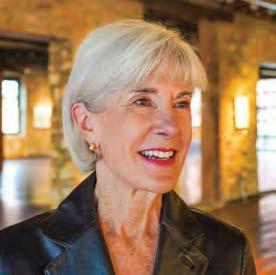

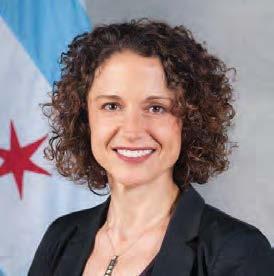


BREAKOUT SESSION: Future

Thursday, March 23 | 7:30–10:30 AM | The Old Post Office CRAIN’S FORUM PARTNERS Keynote Conversation: The State of Our Democracy
Housing
of Behavioral Health
HEIDI HEITKAMP Director, Institute of Politics University of Chicago JAMES CUNNINGHAM Deputy Regional Administrator U.S. Department of Housing and Urban Development
PATRICK J. KENNEDY Former U.S. Congressman (RI); Founder The Kennedy Forum
REGISTER NOW ChicagoBusiness.com/ForumLive
MARISA NOVARA Commissioner Department of Housing, City of Chicago MATT RICHARDS Deputy Commissioner of Behavioral Health Chicago Department of Public Health DEVAL PATRICK Former Governor of Massachusetts; Co-Director and Professor of Practice Harvard Kennedy School for Public Leadership KATHLEEN SEBELIUS Former U.S. Secretary of Health and Human Services; CEO Sebelius Resources LLC
Connecting Talent with Opportunity.
general counsel to Lisle-based Navistar, a public company. Yet she encountered a document even more dense and inscrutable than anticipated.
“ e budget is very di cult to get your arms around,” says Smith, who retired in November after serving 11 years on the City Council.
She also faced a budgetary process that seemed designed to minimize aldermanic input. Chicago’s budgets are crafted by City Hall sta ers who report to the mayor, rather than to the City Council, and the city’s 50 aldermen don’t learn the contents of the mayor’s annual budget proposal until the same October day the public does, with less than a week to prepare for the hearings that council members rely on to inform their votes.
ose budget hearings aren’t just rushed; they also frequently veer o topic. e City Council lacks the authority to compel department heads to appear at its meetings — except for the legally mandated appearance at the annual budget hearings. Chicago Transit Authority leader Dorval Carter Jr., for example, declined a series of requests to appear before the council’s Transportation Committee last year, and only nally showed up for the CTA’s budget hearing in November.
e result?
“Our city budget hearings are really not budget hearings,” says Smith. “ ey’re more like oversight hearings.”
Indeed, a comparative analysis of budget hearings in Chicago and Los Angeles by a team of University of Chicago graduate students found that budget hearings in Los Angeles are about 50% more likely than Chicago’s to focus on nancial matters.
And Chicago’s nances have suffered from the lack of oversight — exacerbated by the fact that Chicago doesn’t have an elected controller, unlike peer cities such as New York, Los Angeles and Houston.
Chicago’s net position — the ratio of all of its assets relative to its liabilities — fell by $11.6 billion in the decade between 2012 and 2021. Not only is that the steepest decline among America’s 10 largest cities, but eight of the 10 (all but Chicago and New York) saw net increases over the same period.
Digital Analytics Manager
Pensions are the main culprit, but not the only one. Chronic structural budget de cits have given rise to bad practices such as “scoop-and-toss” borrowing, in which expiring bonds are repackaged into additional bonds, pushing repayment dates into the future and adding billions of dollars in interest costs. en there’s the city’s habit of using one-time revenues to cover operational expenses — a tradition that continues in the city’s 2023 budget, which relies on a $40 million casino prepayment to cover structural operating costs.
e result is a scal mess. Chicago’s property taxes are among the highest in the nation, driven higher in part by rising pension
contributions that now consume more than 20% of the city budget.
e city’s BBB credit rating from Fitch Ratings is seven notches below the AA-and-above range where most cities reside. Philadelphia is the only other top-10 city with a rating below AA—and its A rating is still three notches higher than Chicago’s.
e upshot? Chicago is deep in debt and hard-pressed to nd money to fund current priorities.
“With a city that is contending with so many legacy liabilities, there is that tension between current policy and programming versus paying down what are essentially incurred costs from the past,” says Ashlee Gabrysch, regional manager of Midwest tax-supported ratings at Fitch Ratings.
It’s a scenario that aldermen have seen coming for years, without doing much about it. Some wrestled with a sense of being boxed out of meaningful engagement with the budget process, while others accepted mayoral control of the budget with resignation.
“With the limited resources I had, I would try to focus on the city budget because that’s the most important vote that aldermen take every year,” says former 49th Ward Ald. Joe Moore, who served on the council from 1991 to 2019. “But the reality is, information is power, and all the information resides” with the mayor’s team.
Still, shortsighted mayoral budgets only pass if the City Council signs o on them. Alderman can vote “no” or “not voting” if they are opposed or unprepared to vote on any piece of legislation. Yet in each of the ve years from 2000 to 2004 when the city began its pension-debt slide, Daley’s budgets were approved with unanimous 50-0 votes from aldermen.
ere wasn’t a single vote in ve years against budgets that steered Chicago straight toward a nancial cli . at sort of record takes more than being boxed out — it also requires a thorough disinterest in rebounding.
“Our budget process is a re ection of the way in which the City Council has approached governance for the past 50 years: As an alderperson, you put your blinders on when it comes to citywide issues, and you focus on the things that are impacting your ward and that you can unilaterally control,” says 35th Ward Ald. Carlos Ramirez-Rosa. “ en when it comes to big citywide policy, you defer to the mayor.”
A culture of ward-level myopia is partly to blame. So is the practice of horse-trading, in which mayors support ward-level aldermanic pet projects in exchange for budget votes. Mayor Lori Lightfoot leaned into that longstanding tradition in 2020 when she warned the council’s Black Caucus not to expect future City Hall cooperation on ward-level issues if they voted against her budget.

Yet in 2011, when Smith took o ce and the pension problem dominated the headlines, that sort of deference wasn’t as universally
appealing as it had been throughout much of the Daley administration. So along with two fellow aldermen, second-term 3rd Ward Ald. Pat Dowell and fellow freshman Ameya Pawar from the 47th Ward, Smith decided to create an independent nancial o ce that would equip the council to more thoughtfully participate in the city’s budget process.
She modeled the o ce on a similar one in San Diego, and Chicago’s City Council voted to create the City Council O ce of Financial Analysis, or COFA, in 2013.
Ten years later, it still exists.
But it barely resembles its counterpart in San Diego.
And Chicago’s pension problem has grown into a monster, with the funding levels for the city’s four pension funds now sharply lower than when Smith was elected.
e largest of those funds, which serves the city’s municipal employees, kept falling during the 2010s and was funded at just 21.9% at the end of 2021, according to an actuarial report issued by the fund in May 2022. For comparison, the average funded level of America’s 100 largest public pension funds is 72.8%, according to Seattle-based actuarial rm Milliman.
To make up for years of underfunding, Chicago now has to contribute increasing amounts to pensions every year. Since 2015, required annual contributions to city pension funds have climbed nearly vefold to $2.4 billion, representing 20.1% of Chicago’s 2023 budget.
Chicago’s xed costs as a percentage of overall expenditures is the highest of any of America’s 20 largest cities, according to an S&P Global Ratings report issued last fall. In fact, it’s not close: 43.4% of Chicago’s costs were xed, according to S&P, and the next closest city was Dallas, at 30.6%.
And Chicago’s budgetary process remains largely the same, including aldermen who feel sped-up,
20 MARCH 6, 2023 • CRAIN’S CHICAGO BUSINESS CLASSIFIEDS Advertising Section
place your listing, contact Suzanne Janik at (313) 446-0455 or email sjanik@crain.com .www.chicagobusiness.com/classi eds CAREER OPPORTUNITIES CAREER OPPORTUNITIES CAREER OPPORTUNITIES CAREER OPPORTUNITIES CAREER OPPORTUNITIES ChicagoBusiness.com ChicagoBusiness.com/CareerCente r
To
From to p ta lent toto p em pl oyers, Crain’s Career Center is the next step in your hiring process or job search Get started to day CAREER OPPORTUNITIES Visit crain.com/careers/ for more information and available positions. Chicagoland’s latest business news and events.
looking for a Digital Analytics Manager to join a growing Data & Analytics team. We support all the Crain brands (AdAge, Automotive News, and Crain’s Chicago—among others) with actionable intelligence that helps drive revenue and grow the business.
a team that’s constantly identifying ways to leverage our best-inclass content to continue the expansion of our fast-growing subscription business.
crain.com/careers/ for more information and available positions.
Crain is
Join
Visit
BUDGET from Page 1
Chicago’s budget process minimizes input from aldermen
Former Ald. Michele Smith
under-resourced and ill-informed prior to the annual vote.
COFA: A SHELL OF ITS SAN DIEGO COUNTERPART
In San Diego, the mayor releases a budget proposal by April 15 each year, a document that is based not only on proposals from city department heads, but also on the City Council’s budget priorities. Once the proposed budget is released, the city’s 11-person O ce of the Independent Budget Analyst res into action, working 80-hour weeks to parse the budget, examine the city’s back-end nancial systems and interview department heads so that it can send its 200-page budget analysis to council members in advance of the rst budget hearings in May, leading up to a mid-June vote.
Last July, Fitch a rmed San Diego’s AA credit rating.
New York City has a similar system. Its mayor releases a preliminary budget each year by Jan. 16, kicking o a nearly ve-month process that includes multiple budget proposals and two rounds of budget hearings, with the city’s Independent Budget O ce — which features more than 30 sta ers — producing a series of analyses and issue brie ngs around topics such as police overtime spending and potential sources of savings and revenues.
Last month, Fitch upgraded New York City’s credit rating to AA.
An informed, unbiased take on the mayor’s budget is crucial because “if a council is relying entirely and exclusively on information that is given to it by another political o ce, it handicaps its ability to operate independently,” says Charles Modica, San Diego’s independent budget analyst.
In Chicago, COFA is designed to serve a similar function. But when the budget drops and it’s time to spring into action, COFA’s process looks far di erent.
For one thing, Chicago’s budget hearings begin just a couple of days
after the mayor releases the budget proposal. In 2022, for example, Lightfoot introduced her budget on a Monday and the rst budget hearing followed on ursday. en there’s COFA’s size: two employees.
“I don’t know how two people alone could go through all that,” Modica says. A team of two could formulate “a kind of comprehensive, overarching view, or get very detailed about a smaller segment of the budget. But trying to do it all, that’s a lot.”
Indeed, Chicago’s nonpro t Civic Federation produces its own budget analysis each year, with a team of ve devoting about a month to the project—the organization aims to publish its report just before the City Council’s nal vote, rather than for the start of hearings. Civic Federation acting President Sarah Wetmore says her organization’s report “still has to take a fairly high-level view of the budget, looking mostly at top-level trends.”
COFA seems to agree that it’s understa ed and pressed for time. In 2021, for example, it punted on its budget analysis, arguably its single most important report of each year, saying it “was unable to produce a robust report” given sta ng levels and the tight time frame between the budget’s release and the beginning of hearings. (COFA didn’t respond to multiple interview requests.)
e following year it produced an 11-page budget analysis — again, San Diego’s comparable report typically exceeds 200 pages. COFA called out some of Chicago’s budget tactics such as the “purportedly improved revenue projections” that enabled the city to produce its legally mandated balanced budget, but lacked detail.
Part of the idea behind an independent budget o ce is to meaningfully interrogate the city’s revenue projections on behalf of the council. Cook County, for example, has an Independent Revenue Fore-

WILL A NEW MAYOR
MEAN A RETURN TO RUBBER-STAMP BUDGETS?
For years, Chicago’s City Council had a reputation for rubber-stamping the mayor’s proposed budgets — even during periods such as the early 2000s, when shortsighted budgets helped dig Chicago into its current fiscal hole.
CHICAGO
COUNCIL
casting Commission that provides a second opinion on the county’s own projections. COFA, however, appears limited to snarky skepticism.
And sta size isn’t the o ce’s only problem. COFA’s 2023 budget analysis — expanded to 32 pages — laments a lack of access to city data regarding prior-year expenditures.
at’s noteworthy because the municipal-code statute that governs COFA provides for access to any nancial information its director deems necessary.

Smith knows COFA isn’t yet fullling her vision for producing “the kind of analysis that would give City Council a much more robust tool for making decisions.” Still, she holds out hope that in time, COFA will mature into a more useful part of the budgetary process.
“You have to hammer away at reform,” she says.
AN EXPANDED ROLE
Beyond a beefed-up, empowered COFA and an elongated budget timeline, what else could be done to enhance the City Council’s participation in the budget process?
One idea is to involve aldermen earlier in the process, when “their input can be used to shape the budget instead of waiting until the statutorily mandated budget hearing when most of the important decisions have already been made,” says Shayne Kavanagh, senior manager of research at the Chicago-based Government Financial O cers Association, or GFOA. en there’s added clarity. e GFOA certi es the presentation of both city budgets and annual nancial reports for meeting usefulness standards. All 10 of America’s largest cities have GFOA-certi ed annual reports, while eight of the 10 also have GFOA-certi ed budgets granted based on criteria such as clarity and comprehensiveness. Chicago and New York City are the only two not to receive the certi cation.
e GFOA doesn’t publicly share
Chicago modeled its City Council Office of Financial Analysis on similar agencies in San Diego and New York City. But compared to those cities, Chicago doesn’t give its analysts — or aldermen — much time to prepare for budget votes.
Not only is Chicago’s City Council Office of Financial Analysis asked to work quickly once the mayor’s proposed budget is released, but COFA also is much smaller than its peers in San Diego and New York City.
the reasons why cities don’t receive its certi cation. But there may be clues elsewhere, such as in the Civic Federation’s recommendations for Chicago’s budget process. Wetmore says the organization would like to see greater detail regarding why the city believes its various revenue sources will produce the amounts projected within the budget.
Another possibility is a midyear check-in. “Once the City Council votes on the budget, they leave it alone until the next year—and that’s probably a mistake,” says Dick Simpson, a retired professor of political science at the University of Illinois Chicago and a former alderman. He says those midyear reviews would allow the council “to get a better handle on what’s happening, and to be better prepared for what might be needed in the next year’s budget.” at education is key because, if aldermen are to be more involved, well, you want them to constructively involved. For example, the city has made recent scal progress under current CFO Jennie Huang Bennett and Budget Director Susie Park, impressing ratings analysts by showing transparency and moving away from sketchy tactics such as scoop-and-toss and toward smarter ones such as actuarily de ned pension contributions, according to Michael Rinaldi, senior director in
Fitch Ratings’ public nance group. ere’s no guarantee that those gains continue under, say, a di erent mayoral administration, nor are aldermen guaranteed to advocate for smart scal policy.
Fitch’s brightened outlook on Chicago’s nances — the agency bumped the city’s credit rating up a notch last year, to BBB from BBB— is based on “the trend rather than the absolute placement,” Rinaldi says. “We do have a positive outlook, but that hinges on the ability of the city” to continue along a wise scal path.
Under Lightfoot, Chicago’s annual budget votes are no longer the rubber-stamp a airs they were under Daley or even Rahm Emanuel.
at speaks more to a fractious relationship between the mayor and council than a healthy budget process, according to Ramirez-Rosa, the 35th Ward alderman.

“ at overarching structure is still very much in place. You still have a majority of alderpeople who would prefer to just cede their vote to the mayor, and then ask behind the scenes for the things that they would like,” Ramirez-Rosa says.
What’s his proposed x?
“I think that what’s most needed are structures that enable good governance. And right now, that minimum foundation isn’t there.”
CRAIN’S CHICAGO BUSINESS • MARCH 6, 2023 21
JOHN R. BOEHM
cities with independent budget analysis offices
OF DAYS FROM BUDGET RELEASE TO HEARINGS TO FINAL VOTE STAFF SIZES FOR INDEPENDENT BUDGET ANALYSIS OFFICES
Crain’s reporting Source: Crain’s reporting Source: Crain’s reporting San Diego New York New York San Diego Chicago Chicago Notes: Vote total excludes absent council members. Data is for the budget year. Note: For fiscal year 2023 Days to hearings Days to vote 2000 2020 2001200220032004200520062007200820092010 20212022 201120122013201420152016201720182019 0 40 30 20 10 5 45 50 35 25 15 14 119 33 19 59 11 3 35 2 Passing margin Yay: 35 Nay: 15
CITY
BUDGET VOTES Selected
NUMBER
Source:
Chicago’s arts institutions face fiscal reckoning from trends exacerbated by COVID
model that relies on a combination of ticket subscriptions and philanthropy to bankroll productions and exhibitions.
“ e pandemic has exacerbated downward trends and shifts in the business model in our industry,” said Claire Rice, executive director of Arts Alliance Illinois, the state’s top arts advocacy group. “We just can’t rely on these same models like we did before the pandemic.”
With attendance running 15% to 20% below pre-pandemic levels, CSO, Goodman and Steppenwolf said they expect operating de cits of around a million dollars each this year. e Jo rey Ballet said that without cash surplus reserves saved up during the pandemic, the dance company would have a de cit of about a halfmillion dollars.
CSO said it relied on a $10 million Shuttered Venue Operators Grant, or SVOG, from the U.S. Small Business Administration last scal year to help plug what would have been a “fairly signicant de cit.” Goodman’s Chief Financial O cer Lewis Warrick said it used a $5.8 million SVOG grant to balance the previous two budgets. Steppenwolf and Jo rey Ballet similarly relied on government aid to make up for the loss of ticket sales revenue, which was all but
wiped out during the worst of the pandemic.
In total, Chicago arts organizations received $372 million from SVOG grants, with some grantees receiving the maximum award of up to $10 million. While other federal, state and city programs chipped in, the largest amounts came from the SVOG program, which expired last year.
e governmental aid was supposed to keep venues and organizations a oat until crowds returned, but people aren’t coming back at the same rate seen before the pandemic. And the federal lifeline is tapped out.
DWINDLING ATTENDANCE
Chicago Symphony Orchestra Association President Je Alexander said ticket revenue declined from around $23 million in 2018 to $16 million last year, as attendance slid about 20%. Brooke Flanagan, executive director for Steppenwolf, said it has seen a similar drop in attendance.
Goodman reached almost $8 million in ticket sales last year, but that is still short of the nearly $11 million it generated in 2019. Jo rey went from $8.08 million in ticket revenue in 2019 to $5.15 million last year, as attendance declined 12% during that time.
Leaders in the industry say audiences are still reluctant to ven-
ture back out and some believe it will take three to ve years before crowds return to full strength, if at all.
“People need to break up with their Net ix and streaming devices and get back out to experience the city’s culture again,” said Chicago Department of Cultural A airs & Special Events Commissioner Erin Harkey.
Subscriptions, or season ticket purchases, a pillar of the industry’s business model, are dwindling. Steppenwolf said subscriptions are down 40% since the start of the pandemic, forcing the theater to rely more on lesspredictable single-ticket sales. Jo rey said it lost around 2,000 subscribers, a 28% decline representing over $600,000 in ticket revenue, since 2019.
While sales are down, expenses have gone up, further straining bottom lines. Steppenwolf’s Flanagan said that costs are up 17% this year from 2019, even though the theater is running one fewer show. She attributes the rise in costs to in ation and additional COVID safety expenses, like personal protective equipment, virus testing and HVAC ventilation.
According to data from the nonpro t Americans for the Arts, 60% of revenue for nonpro t arts organizations comes from earned revenue, such as ticket sales. CSO,
STRUGGLING ARTISTS
While tickets to sporting events have recovered since the worst of the pandemic, performing arts — which include plays, theaters, operas and concerts — are still struggling to rebound.
Goodman, Steppenwolf and Jo rey say ticket sales and other earned revenue used to cover about 50% of operating costs, while donations covered the rest. But with earned revenue down since the start of the pandemic, arts organizations have been forced to rely more heavily on the generosity of donors and governmental aid.
DONOR SUPPORT
While donor support has remained strong at Chicago’s largest institutions, there are fears it won’t continue to keep pace and, like federal aid, will begin to dry
up. “A lot of major foundations in Chicago and around the country have redirected their fundraising and philanthropy away from the arts,” Roche Schulfer, Goodman’s executive director and CEO, noted. Still, many of the industry’s hopes rest on the generosity of its donors and attracting new audiences in the absence of renewed government funding.
“ e industry is begging for investment and stabilization and a collective act to make sure that we don’t lose what this city has spent a century building in the arts and culture,” said Flanagan.
22 MARCH 6, 2023 • CRAIN’S CHICAGO BUSINESS Nominate a healthcare professional who has significantly expanded the business, service or technology side of healthcare and promotes diversity and inclusion in the workplace. Nominations Due March 10 ChicagoBusiness.com/NotableNoms
CULTURE from Page 3
Preforming arts Source:
Tickets to sporting events $0 $70 2017 2018 2019 2020 2021 $60 $50 $40 $30 $20 $10 $55.52 $32.38
AVERAGE ANNUAL CONSUMER EXPENDITURES
BLS Consumer Expenditure Surveys
A treasure trove of fine craft work meticulously restored in a Tudor-style home in Wilmette
Built
are now asking $3.45 million for it I
Walk into this Wilmette house in 2023, and you might think you’re arriving in 1930, when it was brand-new and the height of upper-class style.






“We did everything we could to make it look exactly the way it was built,” says John Nersesian, who with his wife, Lucine, bought the house on Canterbury Court in 2009, when it had been neglected for some years, and undertook a meticulous restoration.
While much of the original finely crafted wood, plaster, limestone and tile was intact, some parts of the paneling had been punched out for utility installation and then replaced with plywood, hand-crafted tiles were broken or missing, and there was standing water in the basement.

”We could see the house needed to be saved,” says John Nersesian, “and we were silly enough to sign up for the job. It’s a piece of artwork we restored.”
The house has a distinguished history that goes be yond its handsome looks. Designed in 1930 by arc hitect Abraham Epstein for a Chicago manufacturing executive, it was later the home of J.L. Kraft, founder of the Kraft cheese empire, and his wife, Pauline. It was also the home of Lee Artoe, a player for the Chicago Bears in the early 1940s, and his wife, Elaine Blatt Art oe, a pioneering attorney who was the only woman in her class at then-Northwestern University School of Law in 1951.
The Nersesians, who raised their two kids in the six-bedroom, 11,000-square-foot house on two-fifths of an acre, now live mostly in Florida. Planning to downsize out into a smaller, part-time home in Wilmette, they are putting the house on the market March 6. The asking price is $3.45 million, and the listing agents are Janet Karabas and Noah Levy of Engel & Völkers Chicago North Shore.
BY DENNIS RODKIN
CRAIN’S CHICAGO BUSINESS • M ARCH 6, 2023 23 EDITORIAL 312-649-5200 CUSTOMER SERVICE 877-812-1590 ADVERTISING 312-649-5492 CLASSIFIED 312-659-0076 REPRINTS 212-210-0707 editor@chicagobusiness.com Vol. 46, No. 10 – Crain’s Chicago Business (ISSN 0149-6956) is published weekly, except for the rst week of July and the last week of December, at 130 E Randolph St Suite 3200, Chicago, IL 60601 $3 50 a copy, $169 a year Outside the United States, add $50 a year for surface mail Periodicals postage paid at Chicago, Ill Postmaster: Send address changes to Crain’s Chicago Business, 1155 Gratiot Ave , Detroit, MI 48207 Four weeks’ notice required for change of address. © Entire contents copyright 2023 by Crain Communications Inc. All rights reserved. HOW TO CONTACT CRAIN’S CHICAGO BUSINESS
in 1930 with the nest wood, tile and plaster work of its era, the house was painstakingly restored in the 2010s by owners who
VHT PHOTOS
With an all-electric future on our horizon, ComEd knows our grid will have to be smarter, more resilient and reliable than ever before. That’s why we’re making investments and upgrading technology today, to ensure we continue to deliver reliable service to you and your family for generations to come. So, when everything goes electric, we’ll be ready. Because lighting your life brightens our day. Record-breaking reliability, powered by ComEd.







When everything’s electric, we’ll be ready.
© Commonwealth Edison Company, 2023











































 BY STEVE DANIELS
BY STEVE DANIELS

























































 BY STEVEN R. STRAHLER
BY STEVEN R. STRAHLER
























